Home Compare Savings Accounts Guide to Spaceship Voyager, the micro-investing platform

Guide to Spaceship Voyager, the micro-investing platform
If you’re wanting to get into the stock market, Spaceship Voyager could help you to start investing.
By Alex Brewster
on 18 Mar 2021

With savings account rates at historically low levels, Australians are flooding into the stock market to get a better return on their savings.
In just under three years, more than 125,000 Aussies have started using Spaceship Voyager. While past performance is not indicative of future performance, the app has delivered solid returns to many of its customers in the past year.
Find out how Spaceship Voyager works, what it costs, and if it may be right for you.
Need somewhere to store cash and earn interest? The table below features savings accounts with some of the highest interest rates on the market.

- A high-interest online savings account with no monthly fees, easy withdrawals and award-winning digital banking
- No withdrawal notice periods or interest rate penalties
Total interest earned $1,001
All products with a link to a product provider’s website have a commercial marketing relationship between us and these providers. These products may appear prominently and first within the search tables regardless of their attributes and may include products marked as promoted, featured or sponsored. The link to a product provider’s website will allow you to get more information or apply for the product. By de-selecting “Show online partners only” additional non-commercialised products may be displayed and re-sorted at the top of the table. For more information on how we’ve selected these “Sponsored”, “Featured” and “Promoted” products, the products we compare, how we make money, and other important information about our service, please click here . Rates correct as of May 18, 2024. View disclaimer.
What is Spaceship Voyager?
Spaceship Voyager is a micro-investing app designed for people inexperienced with investing to get started in the stock market. There is no minimum investment on Spaceship, meaning customers can invest as little as $1, removing the fear many prospective investors have over forking out large amounts of their hard-earned cash.
As opposed to a human financial adviser that gives personal investment advice based on your circumstances, Spaceship Voyager offers a more automated method of investing through it’s technology. While this takes a lot of the guesswork out of investing, it does make it less personalised. However, this can also be much cheaper than consulting a professional, which may make it a more attractive method of investing to those just getting started or people with less disposable income.
Investors can choose to invest in three different portfolios, with the ability to deposit lump sums or set up regular weekly, fortnightly, or monthly top-ups.
You can track the progress of your portfolios through the app and link to an external bank account to deposit and withdraw money.
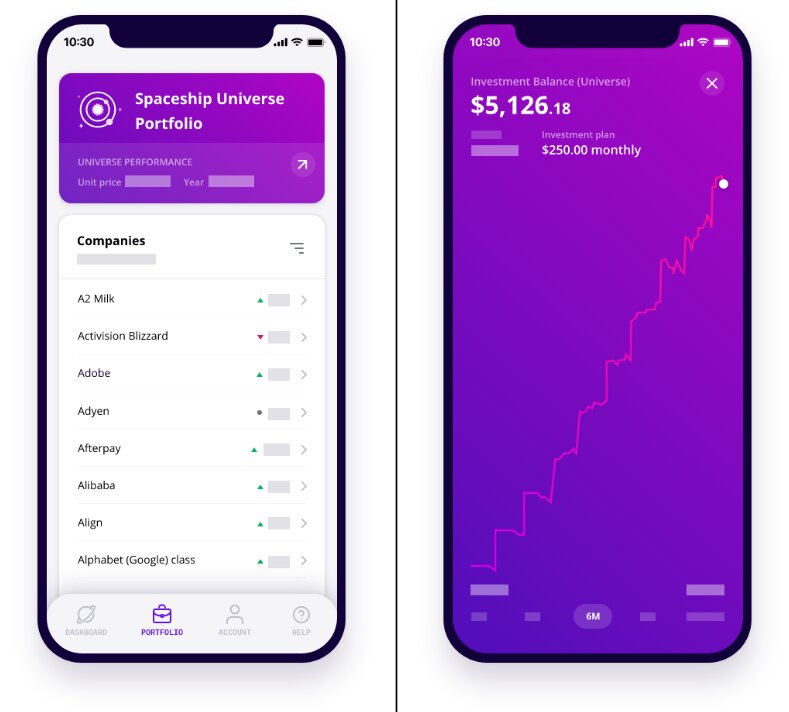
Source: Spaceship
How do you invest with Spaceship Voyager?
Spaceship Voyager allows you to invest in three different portfolios, each made up of shares from various different companies from countries across the world like Australia, the US, China, and Argentina. You cannot customise the investment portfolios. The three portfolios are:
Spaceship Universe Portfolio
Spaceship Universe Portfolio is an actively selected fund of 70-100 companies Spaceship believes satisfies its “where the world is going” (WWG) criteria. The WWG methodology analyses each company’s competitive advantage, and future product or service growth potential. The fund boasts household name US companies like Facebook, Tesla, Apple, and Microsoft, and other prominent Australian companies like Afterpay, Zip, and Seek.
The fund’s assets are typically invested within the following asset allocation ranges:
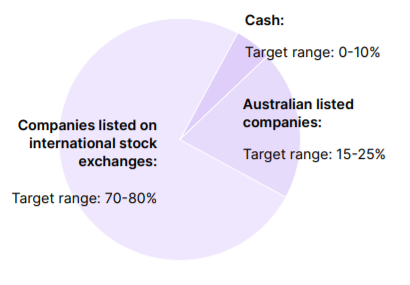
Over the year ending 31 January 2021, the fund achieved a return of 47.84%. In the 32 months from the portfolio’s ‘funded date' on 15 May 2018 till 31 January 2021, it has achieved an annualised return of 29.46% p.a. These returns are net of fees and may seem impressive, but keep in mind the mantra past performance is not a reliable indicator of future performance .
Spaceship has labelled the risk profile for the fund as high as there is higher risk and volatility associated with it compared to some other funds, but with that comes the potential for higher returns in the long term compared to lower-risk investments. The minimum suggested timeframe of investment for this fund is seven years, which means you should be willing to part with any money you invest in this portfolio for at least seven years.
Spaceship Origin Portfolio
Spaceship Origin Portfolio is a passive index fund made up of the top 100 Australian listed companies and top 100 international listed companies as measured by market capitalisation. Spaceship implements an equal-weighted index to decide which companies to include in the fund, rather than a market-weight index, which increases exposure to smaller companies, minimising the influence of larger companies.
The fund features Australian companies like Coles, Commonwealth Bank, BHP, and News Corp, and US companies like Nike, Netflix, McDonald’s, Astra Zeneca, and Amazon.
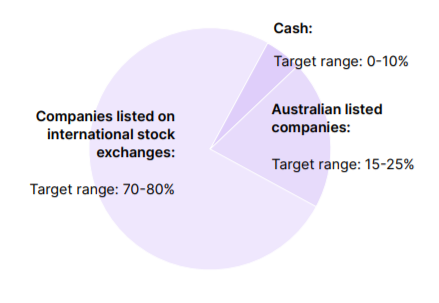
Over the year ending 31 January 2021, the fund returned 2.71%. Since the funded date, 15 May 2018 till 31 January 2021, the fund has achieved an annualised return of 10.05% p.a.
Again, these returns are net of fees and past performance is not a reliable indicator of future performance.
The Origin Portfolio has the same high-risk profile as the Universe Portfolio, and the minimum suggested timeframe for holding this investment is also seven years.
Spaceship Earth Portfolio
Spaceship Earth Portfolio is an actively selected fund of 30 to 50 companies that are considered to have a positive impact on people and the planet, in areas like poverty, climate change, and quality education. The fund uses a negative screening process to exclude companies involved in activities like:
Fossil fuels
Animal cruelty
Human rights abuse
Tobacco and alcohol
Firearms, and controversial and conventional weapons
Nuclear power
The fund also uses the WWG criteria in conjunction with this process to select which companies to include. Companies featured in the fund include Atlassian, Lululemon, Shopify, Adobe, Etsy, Cloudflare, Visa, Square, and Starbucks.
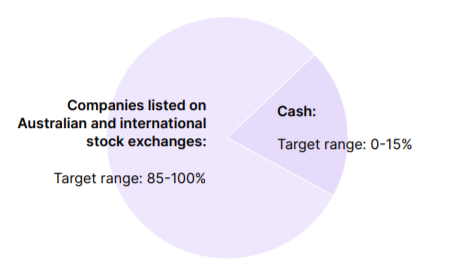
Spaceship Earth was launched in November 2020 and as a result, no investment performance data is yet available.
As with the previous two portfolios, the fund is labelled high-risk and the minimum suggested timeframe for holding investment is seven years.
How much does it cost to invest with Spaceship Voyager?
There are no sign-up fees with Spaceship Voyager, and zero fees on the first $5,000 invested. Investors are charged a percentage of their balance for amounts greater than $5,000, which you can see in the table below. There are also no brokerage fees, withdrawal fees or exit fees.
Who can use Spaceship Voyager?
Spaceship chief executive, Andrew Moore, said Spaceship Voyager was an easy to use, low-cost app, suited to anyone who wanted to get into investing who may have been previously daunted by the prospect.
“Spaceship may suit those who want access to a low-cost, app-based investment product with a focus on global equities,” Mr Moore told Savings.com.au.
“With Spaceship Voyager, you can start investing in a managed fund - with anywhere from 30 to 200 companies - in just a few minutes. We think that appeals to many people, whether you’re just starting out or you’ve invested before.”
Mr Moore said the three different portfolios gave customers a way to invest in a diversified managed fund of global equities.
“Our Spaceship Universe Portfolio has a focus on forward-thinking companies, often with a tech tilt, while our Spaceship Origin Portfolio invests in some of the world’s largest companies by market cap.
“Our latest fund is the Spaceship Earth Portfolio – for Australians who want to invest and have a positive impact on people and the planet.”
What are the benefits of using Spaceship Voyager?
Some of the main benefits of using Spaceship Voyager include:
Easy to use app
No minimum investment amount
Investment in Australian and overseas markets
Curated news and resources to inform you about your investment
Ability to set up weekly, fortnightly, monthly investment top-ups
Mr Moore said Spaceship’s focus was centred on giving Australians a best-in-class investment app.
“In the COVID-19 era, it has never been more important for Australians to be able to make the most of their hard-earned cash. We believe that the key to building wealth over the long term is in time in the market, not timing the market.
“It’s not about jumping in and out of investments in the space of a day. We’re investors not traders. Customers can’t trade options or short stocks with us.”
What are the risks of using Spaceship Voyager?
As with any investment, there are risks to using Spaceship Voyager. These include:
Market risk: Share markets rise and fall, and while the goal of the app is to increase your wealth, if the market falls, your investment may too.
No customisation: Although there is a large range of companies within each portfolio, there are only three portfolios to choose from. You also have no say over what companies are included in the portfolios and cannot customise the portfolios.
Currency risk: The portfolios contain companies from all over the globe. Consequently, fluctuations in exchange rates may negatively affect your investment.
Liquidity risk: It can often take time to access the funds in your account, so if you need quick cash, you may not be able to access your funds for a few days.
How to start using Spaceship Voyager
If you think Spaceship Voyager may be for you, here’s how to get started:
Download the app and create an account or sign up online.
Decide which portfolio you want to invest in. You’ll then be required to submit an application with proof of ID. You must be an Australian resident to use Spaceship.
Link your bank account and transfer funds to make your first investment. Spaceship will send you a confirmation of your investment, along with the number of units you purchased, the entry price of them and the date they were issued.
Continue to invest either by making lump sum payments as you see fit, or setting up recurring investment top-ups.
Withdraw as you see fit. You can request a full or partial withdrawal of your investment at any time, which will be processed during the current or next business day.
Savings.com.au’s two cents
Spaceship Voyager makes it relatively easy to invest and may be suitable for people who don’t have the knowledge, time, or money to seriously invest. It’s still vital you do your own research and keep an eye on how your investments are performing.
All investments come with inherent risks, and while Spaceship has delivered solid returns since its inception, this may not be the case in the future.
Only invest what you can afford to lose.
Photo by Matt Benson on Unsplash

Alex Brewster
Alex joined Savings.com.au as a finance journalist in 2019. He enjoys covering in-depth economical releases and breaking down how they might affect the everyday punter. He is passionate about providing Australians with the information and tools needed to make them financially stable for their futures.
Related Guides

How to prepare if your fixed home loan rate is expiring
With record-low fixed home loan interest rates beginning to expire, how can you prepare for interest rate uncertainty that lies around the corner?

How to choose a block of land for your house build
To the untrained eye, a plot of land on one side of the street may not look so different to the one right opposite. Yet, hidden obstacles lurk beneath the soil or in nearby council offices that could hinder your house build.

Why your home loan application can be rejected after pre-approval

What are the maximum interest-only periods on home loans?

When is the right time to buy your second property?

The 10 best budgeting and savings apps for Australians in 2024

Recourse loans & non-recourse loans explained

Why do house prices seem to appreciate faster than units?

Melbourne housing forecast: Suburbs to watch in 2024

When should I upgrade my car?

Australia's rental crisis: how did it come to this?

How to sell an investment property

The richest 1% club: the dollar bills you need to make it

Expert shares their credit card tips for summer travel

Property expert's eight tips to 'get comfortable with auctions'

6 home renovation projects that may increase your re-sale value

What are the top tax apps?

Get news & tips delivered
By subscribing you agree to our privacy policy
© 2024 Savings.com.au · AFSL and Australian Credit License Number 515843
The entire market was not considered in selecting the above products. Rather, a cut-down portion of the market has been considered. Some providers' products may not be available in all states. To be considered, the product and rate must be clearly published on the product provider's web site. Savings.com.au, yourmortgage.com.au, yourinvestmentpropertymag.com.au, and Performance Drive are part of the Infochoice group. In the interests of full disclosure, the Infochoice Group are associated with the Firstmac Group. Read about how Infochoice Group manages potential conflicts of interest , along how we get paid .
Savings.com.au Pty Ltd ACN 161 358 363 operates as an Australian Financial Services Licensee and an Australian Credit Licensee Number 515843. Savings.com.au is a general information provider and in giving you general product information, Savings.com.au is not making any suggestion or recommendation about any particular product and all market products may not be considered. If you decide to apply for a credit product listed on Savings.com.au, you will deal directly with a credit provider, and not with Savings.com.au. Rates and product information should be confirmed with the relevant credit provider. For more information, read Savings.com.au's Financial Services and Credit Guide (FSCG). The information provided constitutes information which is general in nature and has not taken into account any of your personal objectives, financial situation, or needs. Savings.com.au may receive a fee for products displayed.
Explore the Infochoice Group network: InfoChoice · Your Mortgage · Your Investment Property · Performance Drive
Our company, Savings.com.au, has obtained accreditation as a data recipient for the Consumer Data Right (CDR). You can view our CDR policy by clicking on this link .
Be Savings Smart.
Subscribe to our newsletter.
Is Spaceship Voyager the best low-cost investment app for beginners?
By David Boyd | Verified by Yvonne Taylor | Updated 20 Jul 2022
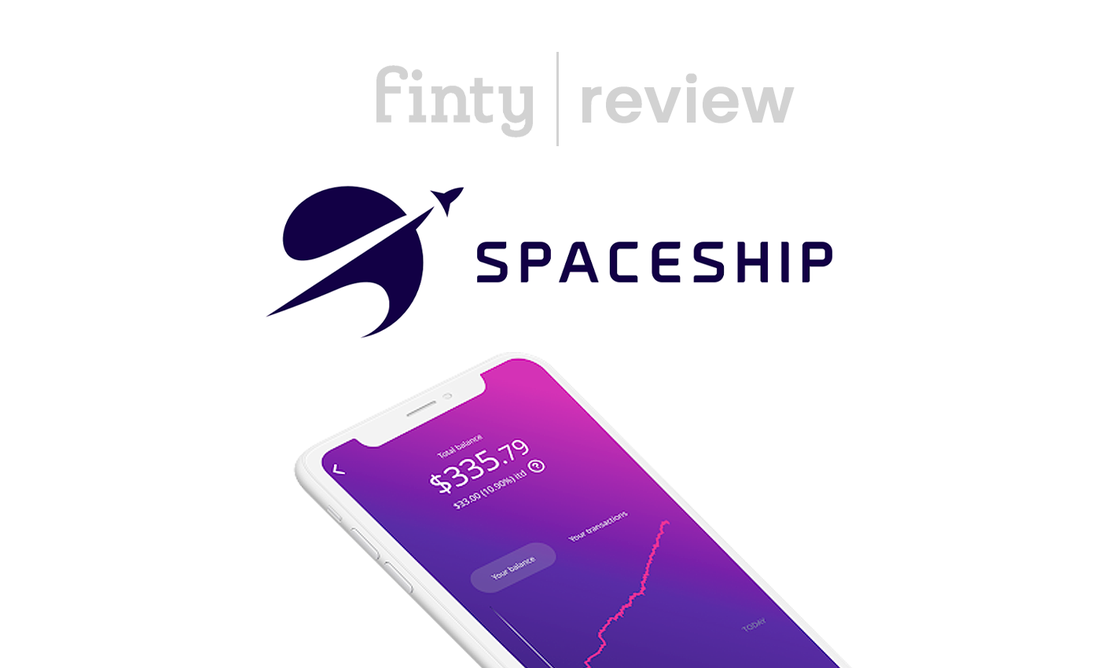
- Choose one of three portfolios and let experts devise your investment strategy.
- No minimum investment, and no fees if your total portfolio balance is less than $100.
- Low $2.50 monthly fee for total portfolio balances over $100.
Spaceship Voyager could be what you are looking for if you'd like to dabble in the stock market but don't know much about investment strategy and would prefer to leave it to the experts.
Getting involved in the stock market has become more and more popular in the last few years – but it can be expensive and risky.
This is why investment apps such as Spaceship Voyager exist. The app is specifically designed for newbies, to help them build up their investment portfolios and access the best advice for getting started.
But is it any good, and will you be an expert by the end of it? In this app review we examine the details and consider the pros and cons, so that you can decide if it's the right choice for you.
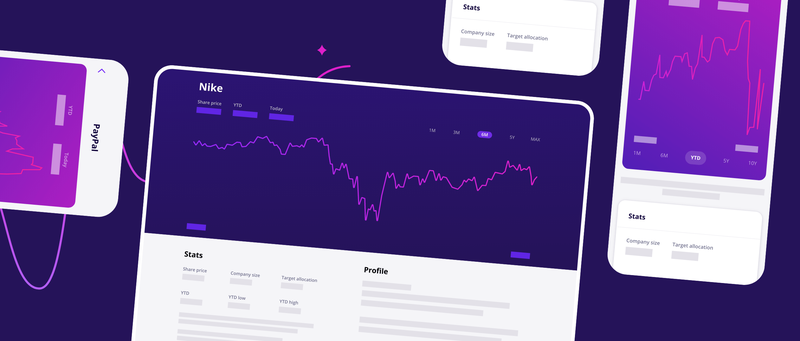
In this review
What is spaceship voyager, how spaceship voyager works, available investment portfolios, how much does it cost, who is spaceship voyager designed for, pros and cons, alternatives to spaceship voyager, comparisons.
Spaceship Voyager is an app specifically designed for non-expert individuals to create and grow an investment portfolio while receiving valuable advice.
An investment platform can be intimidating for anyone, but this one is quite straightforward, and the technology will act as your personal financial advisor.
Fortunately, you don't need to invest much to get started. You can deposit as little as $1 and choose between three managed funds to invest in stocks in Australia and around the world.
Spaceship Voyager takes all the complicated parts of creating an investment fund and simplifies them.
- Download the app. It's free to download. Or set up your account online.
- Sign up. This part isn't too difficult, you just need to pop your data into the form and away you go.
- Choose a portfolio. You can choose between three separate portfolios, depending on how much risk you want to take and how much money you hope to make from the investments.
- Pair up with your bank account/savings account. When you are ready to start, you just need to pair the app up with your bank account so that your investments can be funded. This makes transferring money quick and easy.
Spaceship Voyager investment offers you the option of picking from three different types of portfolio to suit your needs. Which one is right for you will depend on whether you are looking for major global players who have been around for a long time, or want to invest in high-tech companies, or prefer ethical investments.
In fact, you don't have to choose one portfolio to the exclusion of the other two. You can invest in one, two, or all three portfolios.
Spaceship Origin Portfolio
The Spaceship Origin Portfolio is an index fund investing in listed Australian and global shares in amounts according to their market capitalisation. You will be investing in the top 100 Australian and top 100 international companies. Apple , Berkshire Hathaway , Alphabet and Amazon are among the companies that this portfolio invests in.
This portfolio will offer you the opportunity to invest in both the biggest companies in the world, and those local to Australia. Your fees will not be sky high and you can invest in comfort, knowing that the companies you invest in are on a much more stable path.
Spaceship Universe Portfolio
The Universe Portfolio offers a chance to invest in companies hand-picked by the Spaceship Voyager team. They all meet the app's 'Where the world is going' criteria, and include global public companies and large public companies in Australia.
Companies under this umbrella include Spotify, Microsoft and Tesla . The portfolio's past returns have been high, but as always there is no guarantee about future returns.
Spaceship Earth Portfolio
If you are looking to invest in companies that are kind to the planet as well as the sharemarket, then this may be the portfolio for you.
The Spaceship Earth Portfolio, the newest kid on the block, allows you to invest in 50 of the leading companies that are not linked to high levels of pollution, animal cruelty, nuclear power, weapons, gambling, tobacco or alcohol.
This means that you can invest while knowing that you are having a positive impact on the planet and ethically sourcing returns. In a world where we are all being more conscious about how ethical our actions are, this will suit a lot of new investors.
Did you know you can check your credit score on Finty ? It's free and you can check as often as you like.
You won't need much money at all to start creating your Spaceship Voyager portfolio. In fact, you can deposit as little as $1 from the start, and add to it whenever you wish. You can also choose to set up regular weekly, fortnightly or monthly cash top-ups to your investment fund, which makes it a 'set and forget' investment if that's the way you want to play. But if you want to keep track of how your fund is performing you can check out your portfolio and the company profiles provided, with just a tap in the app.
For portfolios with a balance of less than $100, there are no fees payable at all – nothing for depositing funds, withdrawing funds, brokerage or exit fees. Zero, zip, zilch.
But in most cases your portfolio balance will be more than $100. When your balance reaches this stage, you'll be charged a flat monthly fee of $2.50 per account. This means that if you're investing in more than one of the three available portfolios (Origin, Universe, Earth) you will pay only one monthly fee, and no other fees for brokerage, depositing and withdrawing.
This flat fee replaces Spaceship Voyager's previous fees charged as a percentage of portfolio balances, and while the new fee structure is not so good for investors with low balances, it's beneficial for anyone with a healthy and growing portfolio.
For example, if you have $5,000 invested, the fee of $2.50 per month/$30 per year amounts to 0.6% of your balance. But if you have a balance of $10,000, the percentage declines to 0.3%.
These fees are a lot lower than many other investment apps in the industry.
Investing with Spaceship Voyager is mostly aimed towards anyone new to the sharemarket. If you are an investor with little experience with using a trading account and no knowledge of investment strategy, then this may be the right app for you.
The app will advise you throughout the entire process, giving you the best chance to build a successful portfolio. It will talk you through currency risk, interest rate risk, liquidity risk and more.
Spaceship is just one of many apps you can use to streamline your finances and get started with investing. Check out our review of the top personal finance apps for Aussies here .
- Choice of portfolios so that you can select risk, performance history and company type invested in, to suit your preference.
- Low fee structure. Zero for balances below $100, and $30 p.a. (charged at $2.50 per month) for accounts with a total balance of $100 or more.
- No personal expertise required , since the companies you invest in are chosen by experts for each portfolio type.
- Handy app that you can use on your phone and access anywhere.
- Auto top-up option so that you can invest small amounts on a regular basis.
- Regular content updates by the investment team.
- No entry or exit fees, and you can begin with as little as $1.
- Investment choice is restricted to three funds, rather than individual companies.
- There is no guarantee of continuing high returns , so past performance is not necessarily an indicator of future growth.
- Foreign currency risk. Portfolios include investment in overseas shares, and since Spaceship does not hedge against currency exposure (one of the reasons why its fees are so low), your portfolio value could be impacted by currency fluctuations (both negatively and positively).
- Foreign country risks , since your portfolio includes investment in foreign countries which may become financially or politically unsettled.
There are many investment apps competing for your business, and Spaceship Voyager may or may not be the best one for you. Consider these alternatives before you make your final decision:
- Stake . Allows you to invest in US stocks you select yourself. Trades do not incur brokerage fees, but other fees apply.
- Superhero. Trade in over 2,500 ASX-listed products for a flat $5 fee, starting with an investment as low as $100.
- SelfWealth . Invest in companies on the ASX, NASDAQ and NYSE, for a flat fee of $9.50 per trade.
- Pearler . Online trading platform for long-term investors. It includes automated investment top-ups and assists with investment goal-setting. Transaction fees start at $9.50.
- Stockspot . Similar to Spaceship in that you choose a portfolio to invest in (in this case according to your selected risk level) and investment is automated. Invests in ETFs (Exchange Traded Funds) only, with monthly fees starting at $5.50.
- CMC Markets . Trade commission-free in US, UK and Canadian stocks. Low $11 or 0.1% fee for Australian trades, declining the more trades you make in a month. High fees for trades in other countries.
See how Spaceship Voyager compares against other micro investment apps.
- CommSec Pocket vs Spaceship Voyager
- Raiz vs Spaceship Voyager
- Stake vs Spaceship Voyager
Disclaimer: We put our customer’s needs first. The views expressed in this article are those of the writer’s alone and do not constitute financial advice. Advertisers cannot influence editorial content. However, Finty and/or the writer may have a financial interest in the companies mentioned. Finty is committed to providing factual, honest, and accurate information that is compliant with governing laws and regulations. Do your own due diligence and seek professional advice before deciding to invest in one of the products mentioned. For more information, see Finty’s editorial guidelines and terms and conditions .
Advertiser disclosure
At Finty we want to help you make informed financial decisions. We do this by providing a free comparison service as well as product reviews from our editorial staff.
Some of the products and services listed on our website are from partners who compensate us. This may influence which products we compare and the pages they are listed on. Partners have no influence over our editorial staff.
For more information, please read our editorial policy and find out how we make money .

Finty members get
I don't want rewards
I want rewards
Disclaimer: You need to be logged in to claim Finty Rewards. If you proceed without logging in, you will not be able to claim Finty Rewards at a later time. In order for your rewards to be paid, you must submit your claim within 45 days. Please refer to our T&Cs for more information.
- Price Tracker
- Advertising & Partnership
- Press Release
- Editorial Policy

- Policy & Regulation
- Blockchain Guide
- Trading Guide
- Bitcoin Guide
- Ethereum Guide
- CoinSpot Review
- Swyftx Review
- Binance Australia Review
- MEXC Review
- BitMart Exchange Review
- Bybit Australia Review
- CoinSpot Mastercard Review
- CoinSpot vs Swyftx vs Binance
- Coinspot vs Binance
- Crypto.com vs. Binance
- CoinSpot vs Kraken
- Swyftx vs Coinbase
- Ethereum Price Predictions
- Bitcoin Price Predictions
- Submit Press Release
- Submit Querry
- Submit Guest Post
- Crypto Wiki

Home » Spaceship Voyager Review 2024: What Are Its Risks?
Spaceship Voyager Review 2024: What Are Its Risks?
You might also like
3commas review, myetherwallet review, cmc markets review 2024: pros, cons & is it safe.
Spaceship Voyager is a micro-investing platform tailor-made for retail investors seeking to grow their portfolio effortlessly. Geared towards passive growth, it opens the doors for everyone with its no minimum investment policy, allowing you to embark on your investment journey with as little as $1. Unlike CommSec Pocket , Spaceship Voyager grants investors access to top ETFs at low fees. Start your investment adventure today with Spaceship Voyager and watch your wealth soar!
What Is Spaceship Voyager?
Spaceship Voyager is a user-friendly micro-investing platform designed for individuals new to investing, providing an easy entry into the stock market. With no minimum investment requirement, even as little as $1 can be invested, alleviating the fear of committing large sums of money.
Spaceship Voyager employs an automated technology-driven approach to offer personalised advice, reducing guesswork in investing. However, this method proves significantly more cost-effective than consulting a professional, making it an appealing choice for beginners or those with limited disposable income.
Investors can select from three distinct portfolios and have the flexibility to deposit lump sums or establish regular weekly, fortnightly, or monthly top-ups. Spaceship Voyager empowers users to monitor portfolio progress and seamlessly link an external bank account for convenient deposits and withdrawals.
Spaceship Voyager Investment Portfolios
Spaceship Voyager presents three diversified portfolios, each comprising shares from a wide array of companies spanning various countries worldwide, including Australia, the US, China, and Argentina.
Spaceship Universe Portfolio
Spaceship Universe Portfolio is a thoughtfully curated fund comprising 70-100 carefully chosen companies that align with Spaceship’s forward-looking vision called “where the world is going” (WWG) criteria. To make selections, the WWG methodology assesses each company’s competitive advantage and potential for future product or service growth. The portfolio includes renowned US companies like Facebook, Tesla, Apple, and Microsoft and prominent Australian companies like Afterpay, Zip, and Seek.
Regarding asset allocation, the fund typically invests within specific ranges as follows:

Over the one year ending on 31 January 2021, the fund impressively achieved a return of 47.84%. During the 32 months from the portfolio’s “funded date” on 15 May 2018 to 31 January 2021, it reached an annualised return of 29.46% p.a. These returns, while notable, should be considered alongside the reminder that past performance may not reliably indicate future performance.
Spaceship designates the risk profile for this fund as high due to its increased risk and volatility compared to some other funds. But it also presents the potential for higher long-term returns than lower-risk investments. Investing in this fund requires a minimum suggested timeframe of seven years, indicating a commitment to retaining your investment for at least that duration.
Spaceship Origin Portfolio
Spaceship Origin Portfolio is a passive index fund that comprises the top 100 Australian listed companies and the top 100 international listed companies based on market capitalisation. To determine which companies to include, Spaceship employs an equal-weighted index approach rather than a market-weighted index. This unique strategy enhances exposure to smaller companies while reducing the influence of larger ones.
The fund encompasses well-known Australian companies like Coles, Commonwealth Bank, BHP, and News Corp and prominent US companies like Nike, Netflix, McDonald’s, AstraZeneca, and Amazon.
Regarding asset allocation, the fund’s investments typically fall within the following ranges:

Over the one year ending on 31 January 2021, the fund achieved a return of 2.71%. From its funded date on 15 May 2018 until 31 January 2021, the fund displayed an annualised return of 10.05% p.a.
Like the Universe Portfolio, the Origin Portfolio carries a high-risk profile, and holding this investment for a minimum period of seven years is recommended.
Spaceship Earth Portfolio
Spaceship Earth Portfolio is an actively managed fund comprising 30 to 50 carefully selected companies that positively impact society and the environment. These companies are focused on critical areas such as poverty alleviation, climate change mitigation, and quality education.
To ensure alignment with these goals, the fund employs a negative screening process, excluding companies involved in activities related to fossil fuels, animal cruelty, human rights abuse, tobacco and alcohol, gambling, firearms, controversial and conventional weapons, and nuclear power. This approach is complemented by the WWG criteria, aiding in selecting companies for inclusion.
The fund’s portfolio features reputable companies such as Atlassian, Lululemon, Shopify, Adobe, Etsy, Cloudflare, Visa, Square, and Starbucks.

No investment performance data is available because Spaceship Earth was launched in November 2020. However, the fund is categorised as high-risk, and it is recommended to maintain investments for a minimum period of seven years, similar to the previous two portfolios. By investing in the Spaceship Earth Portfolio, you can play a part in shaping a better future for both humanity and the planet.
Other Features of Spaceship Voyager
Spaceship super.
In 2017, Spaceship debuted as Spaceship Super, an innovative superannuation fund. Over time, the fund expanded its offerings to include an investment platform beyond superannuation. The underlying concept remains consistent, with the super fund aligning its values with the forward-looking vision of “where the world is going.”
As the super industry is highly competitive, Spaceship Super faces challenges due to its lack of an established track record in performance and relatively higher fees than other competitors. For those seeking a superannuation fund, exploring alternative options that offer more favourable benefits may be worthwhile.
Transparency
The Spaceship Voyager website offers transparent and comprehensive information about your investments. Unlike many managed funds that obscure their holdings, Spaceship reveals every company it invests in, providing complete transparency. Each company is listed with its performance chart, ensuring you have clear visibility into your portfolio.

While you won’t find specific allocation percentages for each company, you can quickly access performance numbers as they are listed alphabetically. Even during challenging times, like the negative returns experienced in 2022, Spaceship boldly presents the performance figures in prominent display, ensuring you clearly understand your investment’s performance.
Market Updates & Education
Periodically, Spaceship updates the changes made to their active portfolios – Universe and Earth – including the rationale behind these decisions. These updates serve as valuable insights into the team’s efforts to construct a robust and dependable portfolio on your behalf.
The provided information is genuinely helpful in gaining a deeper understanding of the investment process. It sheds light on the fluctuations experienced and emphasises the significance of focusing on long-term growth, imparting a clearer perspective on the journey of investing.
Spaceship Voyager Fee Structure
Spaceship Voyager implements a simple fee structure for its users. For those with a portfolio balance of $100 or more, a monthly fee of $2.5 is charged, encompassing all three portfolios. Each portfolio incurs a management fee calculated as a percentage of the net asset value.
The Spaceship Universe and Earth portfolios carry an annual management fee of 0.50%, while the Spaceship Origin Portfolio is charged at 0.15% per year. All fees and costs include GST and net of reduced input tax credits.
The management fee for each portfolio is calculated as a percentage of the net asset value (your balance). Investing an amount that can yield a return exceeding the incurred fees is generally recommended to ensure your investment remains cost-effective.
For instance, let’s consider an investor with $1000 invested in the Spaceship app, paying a management fee of 0.50% per year (Earth or Universe portfolio). The annual cost of the portfolio would amount to $35. Therefore, a desirable investment amount would generate a return of more than $29 per year, which equates to a 2.9% return for a $1000 investment.
To illustrate how fees may vary with different investment amounts such as $1000, $10,000, or $50,000, here is a breakdown of the annual costs for each portfolio based on their respective management fees:
Spaceship Universe/Earth (0.50% management fee):
- $1000 investment: $35 per year
- $10,000 investment: $350 per year
- $50,000 investment: $1750 per year
Spaceship Origin (0.15% management fee):
- $1000 investment: $15 per year
- $10,000 investment: $150 per year
- $50,000 investment: $750 per year
Please note that these figures are based on the management fees associated with each portfolio and provide an overview of the potential costs for different investment amounts.
As you can see, the cost of having a portfolio in Spaceship increases with the amount you invest. The clear and favourable option here is the Origin portfolio, which boasts the lowest fees while still delivering commendable performance.
Let’s crunch the numbers for a $50,000 investment in the Universe or Earth portfolios. The percentage cost of fees for these portfolios comes to 0.548%, creeping beyond the low-cost range. In my book, anything under 0.50% per year qualifies as low cost.
On the other hand, the Origin portfolio incurs fees at a rate of only 0.198% per year, making it an obvious choice for the most economical Spaceship portfolio.
Spaceship Voyager’s Target Users
According to Spaceship’s CEO, Andrew Moore, Spaceship Voyager is a user-friendly and cost-effective solution for anyone interested in investing, especially those who may have been hesitant about it in the past.
“Spaceship Voyager provides easy access to a low-cost, app-based investment product with a global equities focus,” stated Mr Moore. He emphasised that the platform enables users to begin investing in a managed fund of 30 to 200 companies within minutes, appealing to beginners and experienced investors alike.
Mr Moore explained that the three distinct portfolios offered by Spaceship cater to different investment preferences. The Spaceship Universe Portfolio emphasises forward-thinking companies, often with a tech-oriented approach.
Meanwhile, the Spaceship Origin Portfolio invests in some of the world’s largest companies based on market capitalisation.
The latest addition to their range is the Spaceship Earth Portfolio, ideal for Australians seeking to impact both people and the planet through their investments positively.
Concerns With Spaceship Voyager
Like any investment platform, using Spaceship and investing in their select portfolios has inherent risks. Some of these risks include, but are not limited to:
- Market Risks: The Spaceship Universe portfolio, closely tied to top tech stocks in the US, is subject to market volatility and political uncertainty. Investing in high-growth tech stocks can carry significant risks.
- Stock Risks: As the Spaceship portfolios are hand-picked, investors need more flexibility to add or remove specific stocks. This lack of active management may pose risks associated with limited control over the portfolio’s composition.
- Liquidity Risks: Spaceship Voyager caters to small investors, and there may be more suitable platforms for large-scale investments. For substantial investments, traditional brokerages like CommSec may be more appropriate.
While Spaceship offers promising investment opportunities, it is crucial to be aware of these risks and consider your individual investment goals and risk tolerance before making any decisions.
How To Get Started With Spaceship Voyager
If you’re considering using Spaceship Voyager, follow these simple steps to get started:
- Download the app or sign up online to create your account.
- Choose the portfolio you wish to invest in. As an Australian resident, you must apply with proof of ID.
- Link your bank account and transfer funds for your initial investment. Afterwards, Spaceship will send you a confirmation detailing the number of units purchased, their entry price, and the issuance date.
- Continue investing by making lump sum payments whenever you prefer or setting up recurring investment top-ups.
- Whenever you need, you can withdraw your funds. Request a full or partial withdrawal, which will be processed during the current or next business day.
With these steps, you’ll be on your way to starting your investment journey with Spaceship Voyager.
Alternatives To Spaceship Voyager
As you explore different investment apps to find the best fit for your needs, consider these alternative options alongside Spaceship Voyager:
- CMC Markets: Offers commission-free trading in US, UK, and Canadian stocks, with a low $11 or 0.1% fee for Australian trades, reducing with higher trade volumes. Note that trades in other countries may incur higher fees.
- Pearler: An online trading platform tailored for long-term investors, featuring automated investment top-ups and assistance with investment goal-setting. Transaction fees begin at $9.50.
- SelfWealth: Enables investment in companies listed on ASX, NASDAQ, and NYSE with a flat fee of $9.50 per trade.
- Stake: Allows you to handpick US stocks for investment without incurring brokerage fees, but other fees may apply.
- Stockspot: Similar to Spaceship, it allows you to select a portfolio based on your desired risk level, with automated investments in ETFs (Exchange Traded Funds). Monthly fees start at $5.50.
- Superhero: Offers trading over 2,500 ASX-listed products for a flat $5 fee, with a minimum investment starting at $100.
By considering these alternatives, you can make an informed decision that aligns with your investment goals and preferences. Each platform offers unique features and fee structures, allowing you to choose the one that best suits your investment strategy.
Spaceship Voyager FAQs
What is the minimum investment.
Spaceship Voyager is ideal for beginners in investing. With a minimum deposit of $5 and the freedom to add funds as desired, it provides a fee-free trial until reaching $100. Setting up recurring investments allows for a “Set & forget” approach, making investing in the stock market easy.
Can I select more than one portfolio with Spaceship?
Spaceship now enables multiple portfolio investments, allowing you to invest in all three if desired, unlike the previous restriction of one per account. Their website offers transparency, displaying all included stocks for each option and easily digestible performance data for your research convenience.
Can I withdraw money from my Spaceship account?
To withdraw funds from your investment, use the Spaceship app to request a withdrawal. Alternatively, reach out via email at [email protected] , the Help tab in the app, or the live chat on the website’s lower right corner.
How are unit prices calculated in Spaceship Voyager?
The unit price of each portfolio is determined by dividing the fund’s net asset value by the number of units in the fund. As the market value of the net assets fluctuates, the unit price will also vary. The portfolios invest in international stock markets, and the unit price for a business day is calculated after 11 am on the next business day, as those markets typically close the following morning.
How are my investment returns calculated?
Your investment return is determined by the change in the unit price of the chosen fund (Origin, Universe, or Earth) from when you acquired units to when you redeem them for cash upon withdrawal. For instance, if you invest $1,000 at a unit price of $1.00, you receive 1,000 units. If the unit price increases to $1.20 in two years, your investment would be worth $1,200, reflecting a 20% gain.
The Bottom Line
Spaceship Voyager offers new investors an excellent and cost-effective opportunity to begin their journey. With well-diversified portfolios containing high-quality assets, the platform minimises overall volatility. We highly recommend the Spaceship Voyager app for all aspiring investors looking to build their portfolios.
Lucas N is Coin Culture's managing editor for people and market, covering opinon, interview and market analysis. He owns Near, Aurora and Chainlink
Recommended For You

In recent years, automated trading bots have become prevalent among traders. Who wouldn't fantasise about a lifestyle where you can unwind on a beach, enjoying Piña Coladas while...

MyEtherWallet, created by the renowned software provider MyEtherWallet, stands out as a robust cryptocurrency wallet solution. Established in 2015 and headquartered in Los Angeles, USA, this software caters...
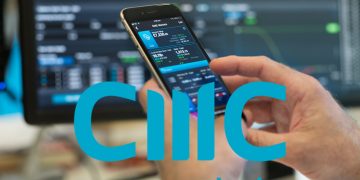
CMC Markets enjoys a solid global reputation for its exceptional trading experience, competitive pricing and diverse instruments. Whether you're a seasoned trader or just starting in the world...
Quantum AI Review 2024: Is Quantum AI Legit or Scam?
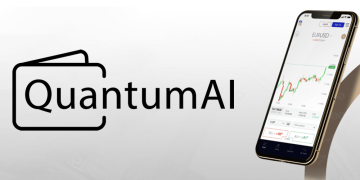
The cryptocurrency market's popularity has surged recently, partly driven by the convenience of crypto trading bots. Quantum AI is among the leading bots, aiming to enhance trading ease...
IC Markets Review 2024: Platforms, Fees & Security

With the volatile nature of the forex market, traders seek reliability and safety for their investments. IC Markets offers automated trading solutions, using intelligent algorithms to trade currencies...

HEX Coin Price 2024: Is HEX A Good Investment?
Most popular.

Cryptocurrency Regulations in Australia: A Brief Overview 2024
Blockfi partners with coinbase for fund distribution, shutting down web platform, mastercard launches ‘next generation’ blockchain payments startup program, iota introduces “iota 2.0” testnet, shifts to proof of stake, guide to crypto twitter: influencers, traders and ventures 2023, recommended.

- Memecoin Launcher Pump.fun Claims Ex-Employee Behind $1.9M Exploit
- Solana Restaking Protocol Solayer Soft-Launches Deposits

- Coinbase Targets Australia’s Self-Managed Pension Funds: Bloomberg

Your Australian news source for all things cryptocurrency. Coin Culture is an independent media outlet that aims to provide an Aussie take on crypto, digital assets, and investing.
Top articles
Browse by tag, recent posts.
© 2023 CoinCulture. All rights reserved.
Welcome Back!
Login to your account below
Remember Me
Retrieve your password
Please enter your username or email address to reset your password.

Add New Playlist
- Select Visibility - Public Private
In this guide
Your reviews
Ask a question, spaceship voyager review.
Spaceship Voyager (Index Portfolio) isn't available on Finder right now.
This fully digital investment platform makes investing your savings easy and convenient.
Spaceship is a popular investment app that offers small automated deposits into managed stock portfolios.
- Consider Spaceship if you want to easily invest small amounts into the stock market without paying high fees.
- Look elsewhere if you want to buy or trade individual stocks or ETFs.
Many people think it's complicated, expensive and time-consuming to invest. But thanks to better education and savvy innovation, investing has never been more accessible and affordable.
What is Spaceship Voyager?
Robo-advice wealth management uses technology to give professional investment advice and investment management without the need to pay a human financial advisor. This has revolutionised not only how we invest in the stock market, but also who can invest in the stock market.
Spaceship Voyager is one of these providers. Their user-friendly app is for “the next generation of newcomers and experts” and allows you to invest your savings into curated investment portfolios.
You can select from two different investment portfolios, and set up regular top ups each week, fortnight or month. Then you let Spaceship Voyager take care of the rest.
Our Spaceship Voyager video review
What portfolios can I choose with Spaceship Voyager?
The platform offers a choice of two portfolios: an index fund called the Spaceship Index Portfolio and a managed share fund called the Spaceship Universe Portfolio.
Both the Spaceship Index Portfolio and the Spaceship Universe Portfolio invest directly in the companies that make up each fund rather than investing via exchange traded funds (ETFs).
Spaceship Index Portfolio
The Index Portfolio is a passive index fund made up of 100 listed Australian shares and 100 listed global shares, chosen using an equal-weighted index of the largest companies by market capitalisation. By using an equal-weighted index rather than a market-weighted index, it reduces the influence of large companies and increases exposure to smaller companies.
The following is the target asset allocation for the Index Portfolio:
- Global large public companies 75% (70-80% range)
- Australian large public companies 20% (15-25% range)
- Cash 5% (0-10% range)
As an example, current holdings as of June 2018 include companies such as Berkshire Hathaway, Boeing, Coca-Cola, Intel, Johnson & Johnson, JPMorgan, Microsoft, Procter & Gamble, Samsung, Toyota, Visa, Walt Disney, Westfield and Woolworths.
Spaceship Universe Portfolio
The Universe Portfolio is an actively selected fund made up of shares in 100 Australian and global companies that are carefully handpicked by Spaceship’s investment team to meet its “Where the World is Going” (WWG) criteria.
The WWG methodology evaluates, among other factors, a company’s competitive advantage, management and risk of disruption from technology. A low WWG rating indicates that a company’s profits are more susceptible to competition and technology disruption over time.
The following is the target asset allocation for the Universe Portfolio:
- Global large public companies 70% (65-75% range)
- Australian large public companies 25% (20-30% range)
Current holdings as of June 2018 include Afterpay, Apple, Baidu, Facebook, Kogan, Netflix, Nvidia, Redbubble, Softbank, Tencent, Tesla, Twitter, Workday, Xero and Zillow.
Can I customise the investment portfolios?
No, you cannot customise the investment portfolios. The fund is a unit trust, so when you invest in the fund, your money is pooled together with other investors and invested in the investment portfolio. You acquire units in the fund and each unit represents a proportionate beneficial interest in the fund’s asset as a whole.
What are the fees to invest with Spaceship Voyager?
Management costs are calculated on gross asset value of the portfolio and accrued daily. It is payable in arrears on a monthly basis as follows:
There are no contribution fees, brokerage fees, withdrawal fees or exit fees charged for either portfolio.
Benefits of investing with Spaceship Voyager
- Transparent . You can easily view your portfolio holdings through your Spaceship account.
- Low fees . You will only have to pay one competitive management fee to run a portfolio.
- Simple structure . Investment portfolios are chosen for you using expert methodology.
- Low barriers to get started . There is no minimum investment amount and there are no entry fees.
- More global and sector exposure . Australia is dominated by companies in the resources and financial industries, so by investing globally, you benefit from increased industry diversification.
- Curated news . An in-house content team delivers content about companies in your portfolio, so you can learn more about your investment.
- Regular investment top-ups . You can set up a regular investment plan to automatically top up your investments each week, fortnight or month. This way, you don’t need to think about your investments and you can “set and forget”.
What are the risks to consider?
All investments carry risk, and the following risks are not unique to Spaceship Voyager alone. Different investment strategies may carry different levels of risk depending on the assets that make up the strategy. Assets with the highest long-term returns may also have the highest levels of short-term risk.
- Market risk . This is the risk of negative returns resulting from unfavourable investment market conditions. Unit values reflect the market value of the assets in the portfolio and consequently may rise and fall in line with market variations.
- Country risk . There is a risk that a country where assets are located could become politically or economically unstable. This risk is generally higher in countries classified as emerging markets.
- Foreign currency risk . Investing in global companies exposes the portfolio to foreign exchange rate movements. Spaceship does not use currency hedging to manage the impact of this risk. When foreign currencies fall in value relative to the Australian dollar, this can have an adverse impact on investment returns.
- Inflation risk . Changes in inflation may impact the value of your investment as inflation reduces the purchasing power of assets or income over time.
- Interest rate risk . This is the risk of investment losses resulting from an increase in interest rates.
- Liquidity risk . This is the risk that you may not be able to convert your investments into cash on a timely basis with little or no loss of capital. During extreme market volatility, Spaceship Capital may choose to suspend redemptions and defer payments for a period of time to protect investors.
How do I get started?
Spaceship Voyager is a fully digital investment product, which means setting up, investing and withdrawing must be done electronically through your Spaceship customer account.
- Create an account via the app or online
- Choose which portfolio you would like to invest in and submit an application. This will include complying with anti-money laundering requirements and providing identification information. You must be an Australian resident to apply.
- Transfer funds to make an initial investment (there is no minimum initial investment for either portfolio). You will receive confirmation of your investment through your Spaceship account. That confirmation will set out the number of units issued to you, the entry price of those units and the date the units were issued.
- Additional investments can be made on an ad hoc basis or you can establish a recurring investment plan. No minimum amount applies to additional investments.
- You can ask to withdraw all or part of your investment at any time through your Spaceship customer account, but it will only be processed during the business day. No minimum amount applies to withdrawals.
Compare with other brokers
- Spaceship Voyager information page
- Spaceship Voyager Universe Portfolio information PDF
- Spaceship Voyager Earth Portfolio information PDF
- Spaceship Voyager Origin Portfolio information PDF
- Spaceship Voyager Universe Portfolio TMD
- Spaceship Voyager Earth Portfolio TMD
- Spaceship Voyager Origin Portfolio TMD
To ask a question simply log in via your email or create an account .
Alison Finder
Hi there, looking for more information? Ask us a question.
Error label
You are about to post a question on finder.com.au :
- Do not enter personal information (eg. surname, phone number, bank details) as your question will be made public
- finder.com.au is a financial comparison and information service, not a bank or product provider
- We cannot provide you with personal advice or recommendations
- Your answer might already be waiting – check previous questions below to see if yours has already been asked
Finder only provides general advice and factual information, so consider your own circumstances, or seek advice before you decide to act on our content. By submitting a question, you're accepting our 1. Terms Of Service and 6. Finder Group Privacy & Cookies Policy .
This site is protected by reCAPTCHA and the Privacy Policy and Terms of Service apply.

Alison Banney
Alison Banney is the money editorial manager at Finder. She covers all areas of personal finance, and her areas of expertise are superannuation, banking and saving. She has written about finance for 10 years, having previously worked at Westpac and written for several other major banks and super funds. See full profile
- Robo Advice
- Micro-Investing
- Risk Profiling
- QuietGrowth
- Raiz Invest
How likely would you be to recommend finder to a friend or colleague?
Our goal is to create the best possible product, and your thoughts, ideas and suggestions play a major role in helping us identify opportunities to improve.
Important information about this website
Advertiser disclosure.
finder.com.au is one of Australia's leading comparison websites. We are committed to our readers and stands by our editorial principles
We try to take an open and transparent approach and provide a broad-based comparison service. However, you should be aware that while we are an independently owned service, our comparison service does not include all providers or all products available in the market.
Some product issuers may provide products or offer services through multiple brands, associated companies or different labeling arrangements. This can make it difficult for consumers to compare alternatives or identify the companies behind the products. However, we aim to provide information to enable consumers to understand these issues.
How we make money
We make money by featuring products on our site. Compensation received from the providers featured on our site can influence which products we write about as well as where and how products appear on our page, but the order or placement of these products does not influence our assessment or opinions of them, nor is it an endorsement or recommendation for them.
Products marked as 'Top Pick', 'Promoted' or 'Advertisement' are prominently displayed either as a result of a commercial advertising arrangement or to highlight a particular product, provider or feature. Finder may receive remuneration from the Provider if you click on the related link, purchase or enquire about the product. Finder's decision to show a 'promoted' product is neither a recommendation that the product is appropriate for you nor an indication that the product is the best in its category. We encourage you to use the tools and information we provide to compare your options.
Where our site links to particular products or displays 'Go to site' buttons, we may receive a commission, referral fee or payment when you click on those buttons or apply for a product. You can learn more about how we make money .
Sorting and Ranking Products
When products are grouped in a table or list, the order in which they are initially sorted may be influenced by a range of factors including price, fees and discounts; commercial partnerships; product features; and brand popularity. We provide tools so you can sort and filter these lists to highlight features that matter to you.
Terms of Service and Privacy Policy
Please read our website terms of use and privacy policy for more information about our services and our approach to privacy.
We update our data regularly, but information can change between updates. Confirm details with the provider you're interested in before making a decision.
Learn how we maintain accuracy on our site.

Spaceship Voyager Review: To The Moon or Engine Failure?
- December 28, 2020
- Last Updated: 1 year ago

Spaceship Voyager Review: Spaceship Voyager offers 3 portfolios to investors looking to set-and-forget.
Twenty-twenty has compounded the continued success of microinvesting apps like Raiz , CommSec Pocket and Spaceship Voyager as millennial investors zealously pour their spare change and more into these low-cost investing platforms.
A reason for this may include one of Spaceship Voyager’s portfolios managing more than 54% in returns in the year ending November 2020, making microinvesting sound like a misnomer.
This begs the question: What’s the catch with the rise in adoption of microinvesting apps and are they a sustainable investing strategy?

If you’re here for a free $5 to start off your Spaceship Voyager investing journey, sign up with my code S8307GS7QC or use my referral link.
For an in-depth breakdown of its features and fees and my personal opinion, read on for one of the most comprehensive Spaceship Voyager reviews on the internet.

Contents – click to jump!
What is spaceship voyager & microinvesting, is spaceship voyager a secure investment.
- The Portfolios
Will I receive dividends from investing in Spaceship Voyager?
How do deposits and withdrawals work, what about competitors, wrapping up.

Spaceship launched in 2016, but did not make available to the public its microinvesting platform, ‘Spaceship Voyager’ until 2018.
It also has a superannuation product known as ‘Spaceship Super’ which kickstarted its business in 2017 and hit 100k users in November 2020.
It is backed by venture-capital firms like Sequoia (the only venture investor in WhatsApp, a Series B investor in Google ), NEA , billionaire tycoon Li-Ka Shing’s Horizons Ventures , and others.
Spaceship raised around AUD 20m during its 2017 Series A funding and about AUD 41m in total during 3 rounds of funding from various investors.

According to Spaceship, microinvesting is ‘when you invest using small amounts of money regularly. ‘
It is an investing model that is used to make investing more accessible to the general public through an easy to use UI, low investment costs and the ability to invest in tiny parcels.
Spaceship Voyager is a microinvesting platform that allows users to pick from one of three managed portfolios and regularly dollar-cost average into the fund as a diversified investment strategy.
The funds hold a variety of both US (NYSE, NASDAQ) and Australian (ASX) stocks to expose investors to a broad range of sectors both locally and internationally.
Spaceship Capital Limited, a registered company with an Australian Business Number (ABN) both issues and is the responsible entity for the portfolios/funds.
All three portfolios have registered Australian Registered Scheme Numbers (ARSNs), which are issued to managed investment schemes like Spaceship Voyager.
That’s why we’ve employed physical, electronic, and procedural safeguards—including 256-bit encryption and Secure Sockets Layer (SSL) — to keep your money and personal information safe. We’ve also appointed an external custodian to hold the fund’s assets. The custodian is the legal owner of the assets, but not the beneficial owner. Spaceship FAQ
However, the odd thing is although they mention the use of a custodian for investors’ assets, they fail to state exactly who they are using as a custodian. Would you trust your money with a custodian you do not even know the name of?

UPDATE 29 Dec 2020: Spaceship has confirmed they use a reputable broker, Interactive Brokers (IB) as their custodian via their live chat support.
Although this is good news, I expected it to be at least mentioned once in their reference guide or product disclosure statement – needing to ask support for something so important is not the way in my opinion.
@Spaceship you need to update your documents!
On the safety of the investment itself – that you’ll have to figure out for yourself based on your risk preferences and perspectives on value.
The Portfolios – Which one to invest in?
Spaceship Voyager has three portfolios: Universe, Origin and the recently launched Earth.
One thing to note about these portfolios is that they all consist only of equities and cash. This means while you are diversified in companies from various sectors and industries, you will be solely investing in stocks and cash (0-10% allocation for Universe/Origin & 0-15% allocation for Earth).
The portfolios do not hold any bonds, money market funds, Bitcoin or commodities (eg gold & silver).
The portfolios are also not exchange traded funds (ETFs) as they are not traded on a stock exchange. It is more like a mutual fund, where the price of the fund/portfolio is updated once daily.
What do you get by investing?
By investing into a particular fund/portfolio, you will receive ‘units’ in the fund/portfolio. These units represent a proportionate beneficial interest in the fund/portfolio’s assets as a whole.
Having a beneficial interest in the assets means your share of the assets as a whole is held on trust for you by Spaceship – while they retain the legal title, you retain the beneficial title and can enforce it against them.

Spaceship Voyager’s most popular portfolio, Universe, is actively managed by portfolio managers who invest in stocks that meet their ‘Where the World is Going’ criteria, which includes major tech companies like:
Along with smaller companies like:
- Ping An Healthcare & Technology
- Pro Medicus
To check out the full list of companies Universe is invested in and the allocations, click here.

The Universe Portfolio has done immensely well over the course of its lifetime since its launch in 2018, having returned over 54% in the year ending November 2020 and over 30% p.a. since its inception in May 2018 till November 2020 (these figures have taken into account fees).
Of course, this year’s returns have been propelled greatly by the great tech boom and recovery that occurred since March 2020, with companies like Tesla and Square returning around 644% and 278% YTD respectively (both of which are part of the Universe portfolio).
A key thing to note is that while past performance is not an assurance of future returns, looking at the companies providing the returns and why they did is key to intelligent and informed investing.
Credit where credit is due: one of my favourite parts about Spaceship Voyager are the little nuggets of information they provide with each investment – the profile, what they like about it and the risks.
Although, I do wish they made it more comprehensive – if you’re listening Spaceship, I want more financial report numbers and competitor analysis!

Origin is Spaceship Voyager’s somewhat passively managed portfolio – because of its thesis to invest top companies globally by market capital through a ‘rules-based investment strategy that identifies companies with large market capitalisations and applies an equal weighting within each asset allocation’.
Thus, despite it being actively managed, it takes has stricter rules to follow, which makes it more akin to index investing rather than an actively managed portfolio.
The rules are:
- Origin aims to gain exposure to the top 100 Australian listed companies and top 100 international listed companies as measured by market capitalisation.
- Companies within Origin are subject to eligibility and accessibility requirements, including whether we can access the relevant stock exchange.
- Origin applies an equal-weighted investment approach within each asset allocation to support diversification and broad sector participation.
- Origin is generally rebalanced on a quarterly basis.
- During a quarter, investment weightings may fluctuate due to changes in the market value of companies.
- Spaceship maintains the ability to invest in more or less than the target number of companies (i.e. we may invest in more or less than 200 companies).
It still holds leading stocks like CSL and Microsoft while investing in safer dividend stocks like Coca-Cola and Visa.
To check out the full list of companies Origin is invested in and the allocations, click here.

Since its inception in May 2018 up till Nov 2020, the portfolio has returned close to 11% p.a. but delivered somewhat lacklustre performance during the year ending Nov 2020, with a performance of only 5.62% , which underperformed compared to the S&P500 which returned approximately 18.6% during the same period, but outperformed the ASX200 which dropped 1%.
This is a lower risk portfolio compared to both Earth and Universe because it has fixed asset allocations which disallow one company’s performance to affect the overall returns by a substantial degree.
The downside however, is that if a few companies do extremely well, the benefit is limited by others going through a rough patch and by nature, its own allocation size.

The new kid on the block is the Earth portfolio, which launched on Spaceship Voyager in November 2020.

Named ‘Earth’ to show its commitment to sustainable investing, it uses the investing approach introduced in Universe (‘Where the World is Going’), coupled with what it claims to be ‘sustainable investing criteria’ which states that investments have to be ‘socially and environmentally acceptable’ and must ‘contribute towards one or more of the UN SDGs’.
To check out the full list of companies Earth is invested in and the allocations, click here.

I would imagine it would not be difficult to find a company that contributes to at least one United Nations Sustainable Development Goal (SDG) – almost every company that is investable by Spaceship Voyager’s standards (exceeding AUD 150m) will definitely at least contribute to ‘Goal 8 – Decent work and Economic growth’.
Greenwashing?
Both the reference guide and product disclosure statement (PDS) are provide nebulous or unsatisfying definitions or qualifications of what Spaceship deems to be sustainable investing, which is deeply troubling for a public product which is marketed to many individuals who may invest based on superficiality rather than careful thought.
While Spaceship Voyager may mean well, I think there should be clearer explanations and guidelines showcased in its PDS or reference guide for a portfolio marketed solely on its focus on sustainability and ethical considerations. (This blogpost does provide more detail about how they crafted the Earth portfolio and probably does a better job than both the PDS and reference guide combined).
For example, Earth currently has a 2.53% allocation to Starbucks (NASDAQ: SBUX), which is not so favourably looked upon by Ethical Consumer, an independent guide on ethical shopping.
Furthermore, it also has an allocation of the same percentage to Lululemon (NASDAQ: LULU) which has been accused of underpaying and overworking its workers in the past.

This just begs the question of how thorough Spaceship actually is with its investment research in the sustainable and ethical space, despite having continuous assessment and removal on the violation of the sustainable criteria.
The Caveat + Workaround
As of December 2020, investors do not have a straightforward process to sign up for more than one portfolio under the same account.
Each investor is limited to one portfolio, and is locked into that portfolio after choosing without the ability to switch between different portfolios or add new ones.
While Spaceship is working on bringing multiple portfolio support, there is a workaround where you can have multiple portfolios under the same account by opening another account with the same email you used initially, but with ‘+new portfolio name’ before the @.
For example:
- 1st portfolio on signup: Universe (email: [email protected] )
- 2nd portfolio that you want to sign up for: Earth (email should be: [email protected] )
By doing this, your second/third portfolio will be under the same account.
Portfolios Summary
The portfolios are benchmark agnostic and have no mention of any benchmarks in either the PDS or reference guide. This makes it harder to put into perspective its returns.
However, one should note that funds like Universe share many holdings with the NASDAQ-100 , which has returned over 50% in the year ending November 2020 (compared to Universe’s ~54% ).
A quick comparison summary of the 3 portfolios:
Spaceship’s fee comparison table:

Short answer: Technically no, but yes.
Long answer: Managed funds do not pay out dividends. Rather, they pay distributions, which are paid annually (yearly within 90 days of 30 June in Spaceship Voyager’s case).
Distributions include:
- Income earned from holding (dividends from the individual stocks)
- Capital gains from the disposal of the fund/portfolio’s assets during the year, taking into account taxable gains and losses.
- Foreign income and foreign income tax offsets
- Franked dividends/franking credits
- Tax deferred distributions.

Spaceship Voyager can only be funded through direct debits from your linked bank account, which has to be linked to Spaceship Voyager when you register for an account.
After linking, you can either manually add a one-off investment or set up an investment plan on a weekly, fortnightly or monthly basis.

If you chose to do a one-off investment, after you lock-in your amount you will receive units of the fund/portfolio you have chosen within 1 business day, if you invested before 5pm the previous day.
However, if you choose to go with a recurring investment plan, ensure your bank’s transaction account has the sufficient funds to go through with each recurring transaction!
Perhaps set-up an auto transfer from your saver to your transaction account with Up Bank so you won’t have to remember to replenish the transaction account after an expensive night out.
Withdrawals work pretty much the same way as deposits do, but in reverse – Spaceship will credit your linked account with any withdrawals (although in my experience it took longer than a business day).
All withdrawals and deposits are free of charge.
If you know the microinvesting space, competitors that come to mind are probably Raiz and CommSec Pocket .
However in this comparison, I’ll include the lesser known microinvesting wildcard from the fund behemoth, Vanguard – the Vanguard Personal Investor (VPI).
For a better mobile experience with the table below, please switch to landscape mode.
There is no doubt Spaceship Voyager has had a phenomenal year – beating out all of its microinvesting rivals in 2020 returns.
However, there has never been a better opportunity to restate the old saying that ‘past performance is not a good indicator of future returns’.
This is especially true as Spaceship has recommended a holding period of 7 years and all of Spaceship Voyager’s portfolios are relatively young at just under 2 years old – anything could happen in the years that follow.
Nevertheless, this doesn’t mean that their performance this year should be discounted – it just means that one should not expect the gravy train to continue on consistently forever.
If you’re looking for a platform that allows you to regularly invest in smaller amounts and you’re willing to take on the higher risks of investing in a fund that allocates solely to growth stocks, then you may want to take a look at Spaceship Voyager.
This platform is a fantastic choice for individuals looking to dollar-cost average while staying hands-off with their investments but still seeking high capital growth.
However, if you have a more conservative risk profile but still wanting to be hands-off, you might want to look at index fund investing on a brokerage or check out a less risky Raiz portfolio with bond allocations.

If you’re looking for a way to expose yourself to some Bitcoin through microinvesting, the Raiz Sapphire portfolio may be something of interest – however I personally would not bother as the fees are unjustifiably high and would recommend buying Bitcoin from a cryptocurrency exchange instead (eg Binance & Australian exchange Independent Reserve ).
For those of you who are more hands-on with investing – I should not even need to explain to you why Spaceship is not for you. Perhaps, in the future if Spaceship allows users to start customizing their portfolios while still keeping costs low it may be worth a second look.

As for VPI, I would not bother with either considering the fees are cutthroat . You’d be better off saving and buying through an actual brokerage instead as VPI will eat through your investments faster than you can say, ‘I started investing!’. Their funds on the other hand, I would highly recommend to index and managed fund investors (eg VGS, VDHG, VTS, VAN0722AU).
An alternative can be found in CommSec Pocket if you’d like to buy ETF units instead to have more control over the variety of stocks your portfolio, but paying AUD 2 on an AUD 50 trade is a bad idea (that’s 4% in fees!). You’d probably want to at the very least invest AUD 200 (1% fee) each time for the platform to be even worth looking at.
Now back to Spaceship Voyager:

In the few queries I have had with Spaceship Voyager support – the response has been friendly and efficient. The best part is you can access support through an easy to use chat-like interface within the ‘help’ section of the app.
Spaceship also offers educational blogposts on its blog, Spaceship Learn which illuminates readers on several subjects like personal finance, investing and using the platform.
The title poses the question, ‘to the moon or engine failure?’
It seems that Spaceship has a clear course set for the moon and beyond – this year Spaceship has really taken off with hitting 100k users and massive returns with its Universe portfolio – no small feat for a homegrown startup out of Sydney.
While it is far from a complete engine failure like Vanguard’s Personal Investor, it still has a few asteroids to steer clear of before it reaches its goal, and only time will tell whether it will ever reach the moon or surpass it.
Whether you’re a newbie looking to start their microinvesting voyage or an investing guru curious about Spaceship Voyager, there’s no better way to test out a platform than by jumping into the deep end and downloading the app (you’ll even get AUD 5 if you use my referral!).
Related Posts

Is Stake Black Worth It?
Save on Stake for steak instead?
Micro-investing with macro returns?

Beem It Review: For Forgetful Friends
More than automatically reminding your friends they owe you

Revolut Australia Review: ‘Superapp’ or Subpar app?
Revolutionary or redundant?
Leave a Comment Cancel Reply
Your email address will not be published. Required fields are marked *
Save my name, email, and website in this browser for the next time I comment.
Dad Investor
January 7, 2024
Which Investing App is Best? (Raiz + Spaceship + CommSec Pockets)
If you're looking for a simpler, better-looking way to buy shares then you'll want to know about these investing apps. I've used them all so want to show you the differences (especially if you're a beginner).

Disclosure: I am not licensed to provide financial advice in Australia and this information should be taken as educational only. Read the disclaimer .

Investment apps have revolutionised how we interact with the stock market.
Gone are the days of needing a fancy broker—now all you need is your smartphone.
Micro-investing apps have been launching in Australia since 2016, but with so many options out there, how do you know which app is the one for you?
But which one should you use? And what might be best for your situation?
By the end of this article, you'll have a clear picture of the best investment apps in Australia.
I'll help you work out which best lines up with your financial goals, making the journey into stock investing a whole lot smoother.
This article will take you through three popular investing apps in Australia that I've been using for years and believe are great options for a range of investors from beginner to experienced.
- Raiz – Diversified portfolios made up of multiple ETFs
- Commsec Pockets – Simple, low-cost online broker for DIY trading of ETFs
- Spaceship Voyager – Simple, transparent funds that are tech-focused on a slick app
The Investment App Landscape in Australia
Investment apps have seriously disrupted the traditional way of doing things.
No longer do you need to schedule a meeting with your suit-and-tie stockbroker or sift through complicated spreadsheets .
These apps have boiled down the complexities of the stock market into a user-friendly experience that fits in your pocket.
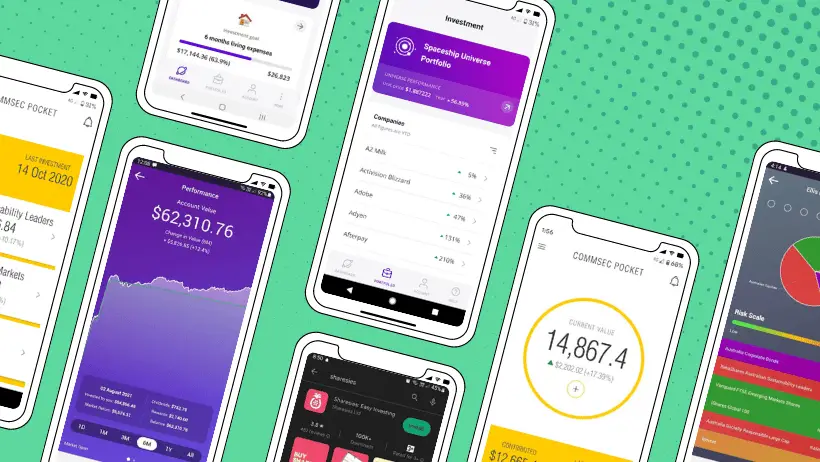
Your leftover dollars and cents from buying a coffee can go directly into your investment account.
These platforms often use a “round-up” feature that takes your purchases, rounds them up to the nearest dollar, and invests the difference.
Micro-investing also means you don't need huge sums of money to start.
It lowers the barrier to entry to invest in shares, making it easy for young folks, students, or anyone who's a bit cash-conscious to get started.
In Australia, micro-investing is gaining traction as a way to invest with little money .
Investment apps have shaken up the traditional finance world, making investing a game that more people can play.
And trust me, you'll want to get in on this action.
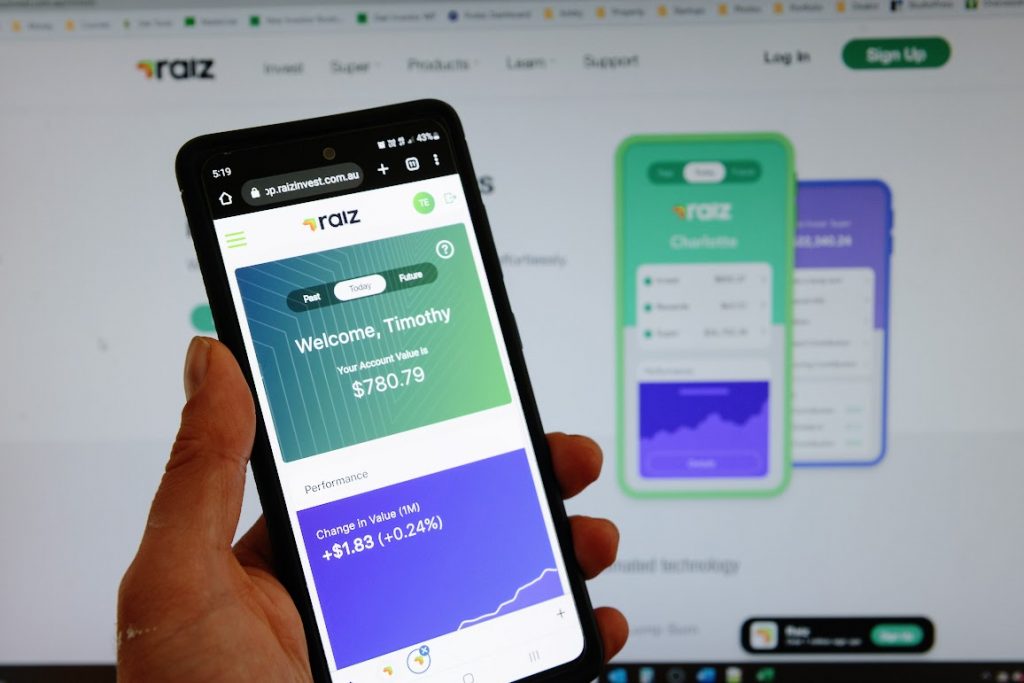
How do these investing apps work?
Just like any app, you download it onto your phone.
Because it's a financial investment product you will need to create an account and enter some personal details.
You will need to set up a connecting bank account as well so the app can directly debit money when you want to invest.
To start investing money you will need to select which portfolio or investment option your money goes into.
Each app has its differences as to what you can select to invest in, which does limit the abilities of each app but also makes it easier to comprehend.
In terms of cost, you will pay a fee to either make a trade (buy or sell an investment) or pay a percentage fee based on your balance each month.
Are investment apps worth it?
While they look flashy and might feel gimmicky, you can use these as a serious way to build wealth.
I've spent the last few years using and trying them out and have found them great alternatives to the online broker option.
One good thing about these apps is that they are targeting new investors so make it easy to get going plus help you out with some educational content.
Also, you can get started with very little money – like $5 and work your way from there. It's like a savings account but different.
If you need some support with investing apps or want to become a successful investor in the stock market, check out my course on building an investment portfolio .
What Makes a Good Investment App?
So, what turns an average investment app into a great one?
Here are some things to keep in mind:
- Ease of Use : An easy-to-navigate interface is crucial. You should be able to perform key actions like buying and selling stocks without needing a manual. Seriously, if you can't figure it out in a few minutes, it's probably not the best investing app in Australia for you.
- Reliability : Imagine this—you're ready to make a trade and bam! The app crashes. Not cool. That's why it's super important to find the most reliable investing app. Look for apps that have been around for a while, so you can invest without worrying about technical hiccups.
- Costs : Fees, charges, more fees! They're everywhere. You've got to be vigilant about costs. Even a small fee can eat into your profits over time. Always read the fine print to know what you're getting into.
- Features : This is the fun part. Some apps come with bells and whistles like auto-investing, round-ups, or even educational resources. Keep an eye out for features that align with your investing strategy .
- User Reviews : Before you dive in, take a dip in the reviews section. It's the real-world testing ground where you'll see if an app lives up to its promises or if it's just hype.
By keeping these factors in mind, you're well on your way to picking an investment app that suits your needs to a T.
Let's start looking at some of the best investing apps in Australia as of 2023.
Business Buddy
Absolutely, here's a draft for the new section:
Top Investing Apps in Australia
Based on my own experience using several investing apps, I want to take you through three popular investing apps in Australia right now.
Even though each of the apps looks and feels similar in how they work there are some key differences.

Click to jump to a summary of any of them
- RAIZ can have you invest in a mix of ETFs, ASX stocks, and portfolios that you add in as little or as much as you like when you like
- Spaceship is like a managed fund where the team picks stocks actively and you invest in a more hands-off way
- CommSec pockets are more like a typical broker where you select an ETF to invest in and buy or sell as many as you like.
It's still early days for all of them in terms of history.
First came Raiz in around 2016, then Spaceship back in 2018 and since then CommSec Pockets was launched in 2019.
Full disclaimer: I've invested in each of these three platforms. I've had experience buying, selling, changing portfolios, and paying fees for each. This article is all based on my own experiences.
I'll go into each and explain what they offer, then provide some reasons one or the other might be suitable for you.
Raiz Breakdown

If you want a simple, all-in-one place to build diversified wealth then Raiz is a great option. Great for beginners wanting options or experienced investors who want simplicity with ETF investing.
- Minimum deposit: $5
- Fees: $3.50-$4.50/mo or .275%/yr of the balance for accounts over $15k
- Options: Portfolios of ETFs, custom portfolios, fractional investing, crypto
- My full review of the platform is available here
Raiz is what I call a “do it for me” investment product.
You set up an account, pick a portfolio (or build your own), and add money to it. You can automate this all, so Raiz literally does it all for you.
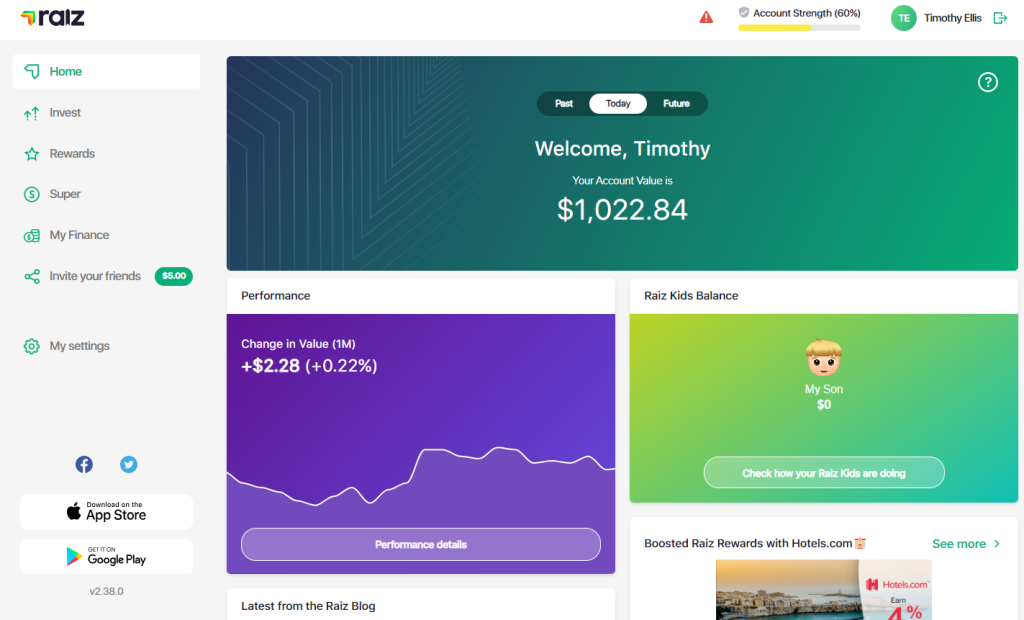
Raiz's portfolio options
Raiz has 7 prebuilt portfolios to pick from as well as an option to build your own custom portfolios (which is what I personally do).
The preset portfolios are made up of well-established ETFs that are a mix of local, and global stocks and bonds, and cash.
Each portfolio has a different balance of stocks and bonds from the conservative option (22% stocks) to the aggressive growth option (90% stocks).
There is also the Sapphire portfolio which includes 5% bitcoin, with 69% in stocks and the rest in bonds.
One of the easiest most diversified ways to get crypto into your investment portfolio.
Raiz Plus allows you to build your own custom portfolio that can include a mix of ASX stocks, ETFs, and the above-mentioned pre-built portfolios.
You build and all in one portfolio with a combination of the following
- 23 ETFs – Diverse Exchange Traded Funds to choose from (see list below).
- 50 ASX Stocks – Handpick from renowned Australian stocks.
- Raiz Property Fund – Get a taste of the Australian residential property scene.
- Bitcoin – A max of 5% allowed to be allocated
It is a great tool for individuals wanting some freedom with regard to asset allocation but aren't interested in stocks individually.
It's a fantastic mix of being in more control of where your money is invested but reducing the need to buy and sell the number of options individually.
For example, you could have a portfolio of IOO, IVV, Telstra, CSL, Woolworths, Property, and Bitcoin in one portfolio.
Some of the ETFs you can pick from include
- AAA – Cash ETF
- STW – Aus Large Cap Stocks
- IEU – Europe Large Cap Stocks
- IAF – Aus Bonds
- IVV – US Large Cap Stocks
- RARI – Aus Socially Responsible
- ETHI – Global Socially Responsible
- FAIR – Aus Sustainable Leaders
- NDQ – Nasdaq 100
- VGE – Emerging Markets
- IOO – Global 100
- IXJ – Global Healthcare
- VSO – Australian Small Companies
- and Bitcoin (but no more than 5% of overall portfolio)
For the full list of ETFs available in the Raiz Plus option read my tips on picking a Raiz Portfolio .
There are higher costs for this portfolio type (an extra $1 a month) but feel it is a very cheap micro-investing app service, saving me time as well.
You can change this portfolio option at any time and always go back to the preselected portfolios or change your ETF/percentage mix as you go.
Raiz's Fees
Raiz makes its money from charging you a monthly fee, as opposed to brokers that charge you when you buy or sell stocks.
I feel that this makes it helpful for those who want to add in smaller amounts or more regular investments.
The ongoing costs for Raiz are reasonable if you have over $7,500 invested.
For the 7 premixed portfolios (everything but custom and Sapphire) It's $3.50 a month when under $15k, then .27% of your balance for those holding more than $15,000. Sapphire is $3.50 a month for all balances or $42 a year.
$3.50 a month is a lot if you have only a chump change in your account. You really need to get to at least $7500 as quickly as possible.
For example, if you have $500 in Raiz, the fees would be $42 a year or 8.4% of your money that will go to fees.
The fees for custom portfolios are higher, with balances below $20,000 being charged $4.50 a month, and balances above $20,000 costing .275% pa.
Fees are due each month and charged from a bank account you setup in the app.
Raiz is completely transparent with its pricing and while they do infrequently increase its fees, it is still an affordable option as you do not have to pay to trade (add or withdraw money) and it keeps your portfolio well balanced.
Other features
Raiz also has a rewards program. You buy something through the apps from one provider and a percentage of that purchase gets sent back to your account. I never use this or think about it but know some people who have done well utilising this. Things like surveys or cashback from online stores are pretty common rewards included.
Raiz has a super fund, which is the equivalent of the portfolios I mentioned (minus the bitcoin option). Personally, I don't have my super in Raiz and feel that their insurance offer isn't the strongest.
- Investing automatically either by a set amount or by rounding up your purchases
- Select from a broad range of well-built portfolios
- Buy fractional shares so can invest immediately
- Rewards Program
- Sustainable options
- All in one / set and forget option
- Need little money to start with
Considerations
- Costly if the balance is under $7.5k
- Easy to make changes (maybe too easy)
- Limited to invest in predetermined portfolios, or selected ETFs
Uniqueness factor
- Fractional micro-investing (any amount of money you have can be invested)
- Rebalancing
- Reinvestment (automated investing)
This means Raiz will allow you to invest with whatever money you have, will make sure your portfolio is balanced the way you prefer, and reinvest any dividends for you.
I believe Raiz is the cheapest way to have the three things done automatically for you.
Spaceship Breakdown

If you are looking to invest in an actively managed fund of growth stocks, then Spaceship is a great option. Suited to investors who want to try micro-investing out for free or specifically invest in tech or planet-focused stocks.
- Fees: $2/mo for any balance over $100 ($0 if under $100) PLUS 0.15% – 0.50% of the value of your amount invested.
- Options: Three active funds managed by the Spaceship investing team
Spaceship Voyager is a spin-off from Spaceship Super that launched back in 2017.
Their philosophy is to look towards “where the world is going” so are big on tech companies across the world. You've all heard of these names Amazon, Adobe, IBM, Google, A2 milk, AfterPay, Tesla are all prominent.
They are very transparent in how they operate which makes it easy to understand their offer, which is that it's a managed fund of selected stocks (As opposed to a group of ETFs).
Investing with Spaceship
The app is very similar to Raiz in that you add money to your account and it gets invested on your behalf.
You can set up a recurring investment or manually add one. There is no round-up option like Raiz so it is a much simpler interface to manage.
Spaceship's portfolio options
There are three investment options to pick from
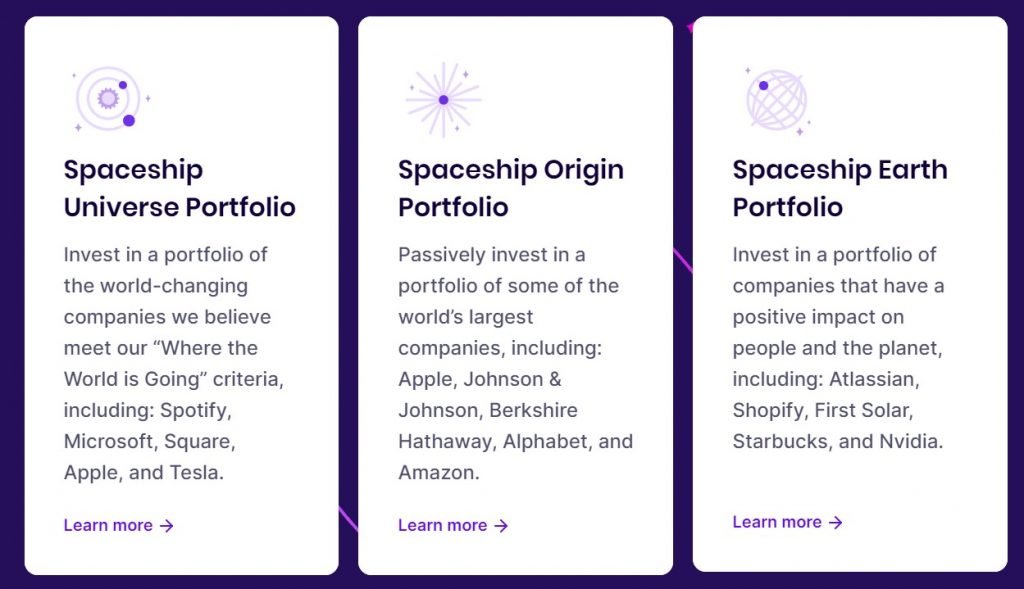
- Spaceship Origin tracks ~200 companies passively following an index
- Spaceship Universe which is actively selecting ~100 companies that change often (higher risk, higher return)
- Spaceship Earth which contains companies that provide a positive impact to the Earth (according to the Spaceship team)
You don't select which companies are in but put your money towards one of the three funds and the company determines what is included in each.
Spaceship allows you to pick more than one portfolio to invest in, meaning if you like all three then you can invest in all three.
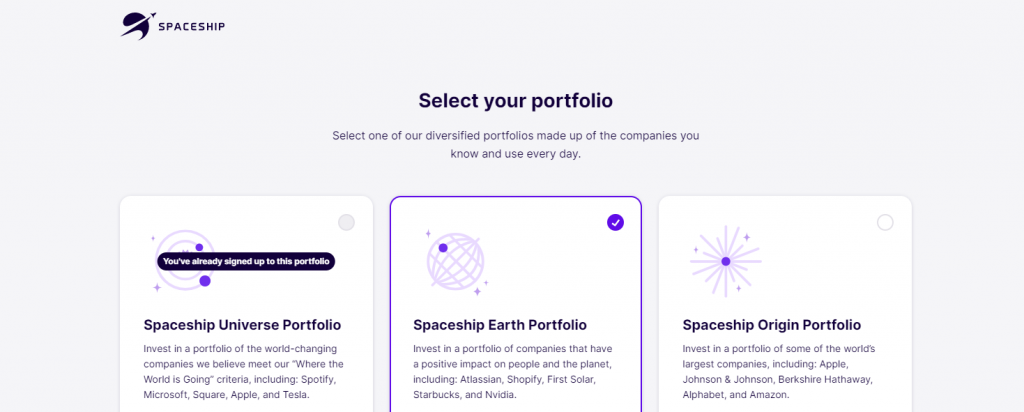
It’s helpful that they are transparent as they outline all the stocks included in each option on their website. You can look at the performance for each pick in a nice-to-digest way (good for when you research).
Note that all portfolios are 100% stocks.
There is no defensive component which means it is more aggressive/risky than holding a balanced portfolio that includes fixed interest and bonds as Raiz does.
What are Spaceship's Fees?
The ongoing fee structure is $2 per month for balances above $100.
The following fees are applicable on top of the $2 per month account fee for each portfolio.
- Spaceship Origin Portfolio: 0.15%
- Spaceship Universe Portfolio: 0.50%
- Spaceship Earth Portfolio: 0.50%
On paper, the Origin Portfolio is the best deal for fees, but the other two have more potential for stronger returns.
Let's run some examples of how the fees might look for two scenarios:
Spaceship Origin Portfolio costs per year
- $1,500 invested will cost $26.25 a year
- $10,000 invested will cost $39 per year
- $100,000 invested will cost $174 per year.
Spaceship Universe Portfolio costs per year
- $1,500 invested will cost $31.50 a year
- $10,000 invested will cost $74 per year
- $100,000 invested will cost $524 per year.
As you can see once your balance starts growing so do the fees.
This should play a part in whether you invest in Spaceship long term or with a higher balance because at these fee rates, there are a lot of other options to consider for the same amount of cost – such as Raiz , or DIY investing through a broker .
You also need to factor in the performance of the funds and think about whether taking .15% of .50% from the overall returns is worth it for you.
One thing Spaceship does well over the others is educating you on investing.
It has a helpful learn section and there is a good feed on investing support and help within the app.
It can help you feel confident and supported, with the app being more than just a balance on your screen.
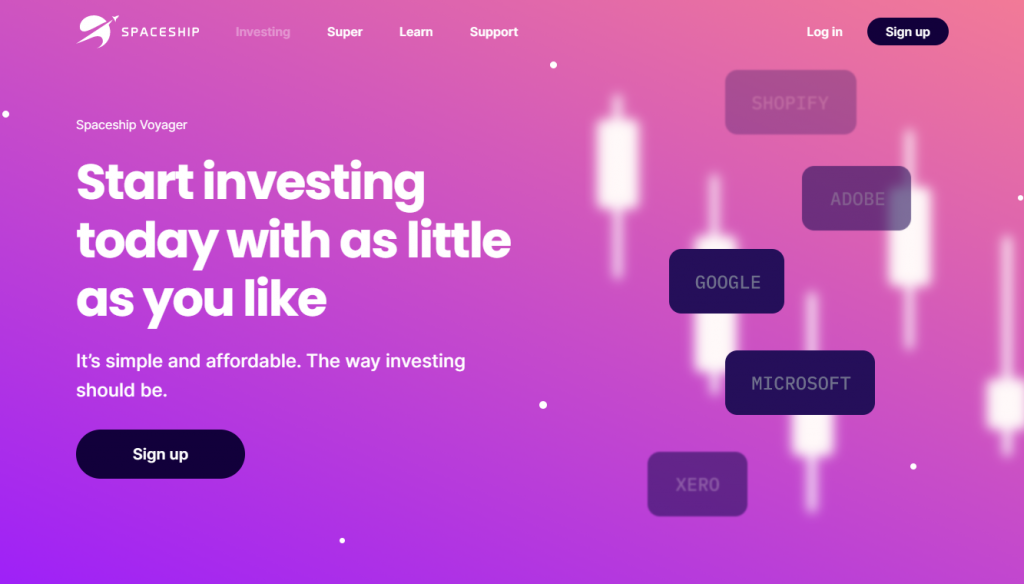
- Free for first $100 (try before you buy)
- Lowe fixed ongoing fee
- Simple three portfolios to pick from
- Well diversified
- Helpful content and education on investing
- Can start with only $5
- Can be automated
- You need faith in the Spaceship investment team
- Options are actively managed rather than passively
- Portfolios are 100% stocks
- The hand-picked mix of stocks and companies with a tech focus.
- Cheap and easy to get started and get knowledge on investing.
- Very transparent in the companies included in your portfolios
CommSec Pockets Breakdown

If you feel confident with investing and want to pick specific ETFs to add to your portfolio then CommSec Pockets is for you. Suited for investors who want to buy and sell ETFs ad hoc or have larger amounts to invest.
- Minimum deposit: $50
- Fees: $2 to buy or sell an ETF up to $1000 in value, no ongoing costs
- Options: Brokerage, ETF investing, mobile-only
Connected with CommSec, Pockets is a new way to buy ETFs at a low cost via an easy-to-use app.
Find more details about the investing app in my full review here
Pockets are more DIY than Raiz or Spaceship, but a still cheap and convenient. Pockets act like low-cost brokers where you can buy and sell a selected mix of ETFs.

Investing with CommSec Pockets
You need to have an existing CommBank account or CommSec account to open an account with Pockets.
It is also an app-only platform – there is no way to use it via the desktop.
What's a bit confusing is that Pockets is completely separate from CommSec standard.
This means your CommSec standard and CommSec Pockets investments show separately if you have both.
Another point of difference from Raiz or Spaceship is that once you transfer money in it is not invested automatically by default.
The process works like this
- Transfer money from your bank to CommSec account
- Manually select an option to invest in via the app
- Complete trade
Very much like a traditional broker experience.
You can set up automatic investments, but you will need money in your account for this to happen. If you wanted to do this you would need to transfer money to your CDIA account in CommSec and pockets would take money out of this at the interval you set.
CommSec Pocket's ETF options
You have seven ETFs that are available to buy like any other broker on the ASX.
These ETFs are similar to what Raiz uses to make up their pre-built portfolios, but in this case, you pick them individually.
In a way, you are building your own portfolio so it's the equivalent to a Raiz custom portfolio.
- IOZ – 200 Australian companies
- IOO – 100 Global companies
- ETHI – Global sustainability leaders
- IXJ – Global Healthcare
- IEM – Emerging markets
- NDQ – Global tech companies
- SYI – High Dividend Yield Fund
Personally, I like all these ETFs. It's all you need for a well-diversified portfolio.
The reason why IOZ was picked as opposed to VAS or A200 is the price per share.
In Pockets, you need to buy the entire stock (not a fraction of it like Raiz or Spaceship). IOZ trades around $25 which is lower than VAS at $90 or A200 at $120 or so. The concept of the app is to make investing more accessible and affordable so buying into Australian stocks at $25 is that.
Note that there is no option for defensive ETFs like bonds or fixed interest which would really make this app become all in one for DIY investors. You can of course buy these at other brokers or hold money in bank accounts to add “defense”.
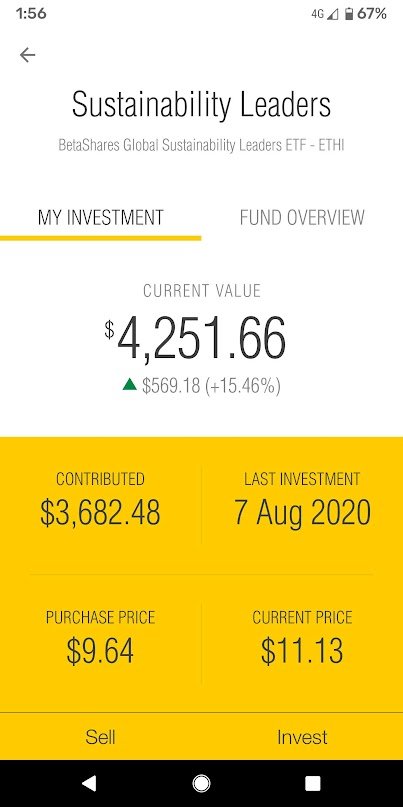
CommSec Pocket's Fees
Fees are simple and clear.
- $2 per trade if under $10000
- eg. if you invest $1500 the cost is $3
There are no ongoing fees (like the other apps) so if you were to invest semi-regular then this might be a cheaper option.
Considering CommSec can charge up to $19.95 for the same trade, it's significantly cheaper if you were buying the same ETFs anyway.
While $2 is cheap, if you are buying or selling often it might not be the best option.
If you were buying fortnightly or monthly basis like I do – you might rack up costs of $52 a year if fortnightly or $24 a year if monthly.
The app is quite nice to use. It is clean and easy to manage.
The tone of voice is helpful to new investors and every step of the trading process has information to help you understand what is happening.
One thing that I love is that it does not give you daily changes in your balance.
Most brokers once you sign in will show you exactly what your balance did for that day.
This isn’t helpful as it grabs at your emotions telling you you’ve won or lost. You really need to be looking at investments long-term (that's why I use Sharesight ).
- As a DIY investor, rather than a set-and-forget type, you can have more control over exactly what you are investing in.
- You can select specific ETFs based on what’s important to you.
- Whether it be a region like global or Australia, which sector, or even a high dividend-paying ETF.
- It is a convenient step up if you already have a CommSec account, but may be too basic if you already invest.
- If you want to build a simple investment portfolio yourself, this is a handy way to start.
- You pay per trade rather than a recurring fee, so if you want to drop a large amount in then it is a better option as you pay once.
Consideration
- While you can invest from $50, the $2 fee would make it costly for trades less than $200. I recommend $500 plus a trade if you want to keep things low-cost
- To a new investor, it may not be obvious what to pick from, so researching of the ETFs and how to build a portfolio is recommended
- All investments are 100% stocks – no diversification across asset types
- You cannot buy fractionally so you need the exact amount to cover the cost of the shares
- Build a DIY ETF portfolio through the one app.
- Select your own individual ETFs at a fraction of the cost.
- Set up recurring investments through a broker.
Investing Apps vs. Online Brokerages
With the modern era of digital investing, there's a difference between these sleek new micro-investing apps and traditional online brokerages.
Apps like Raiz, Spaceship, and CommSec Pockets have made investing as simple as a few taps on your phone. They offer automated investing, fractional shares, and round-up features tailored for beginners with limited capital.
On the flip side, online brokerages such as Stake and Webull provide a more hands-on approach to investing, appealing to those who seek a broader range of investment choices like individual shares, comprehensive market data, and advanced trading tools.
These platforms often cater to a more experienced audience who value in-depth analysis and the flexibility to craft a more personalised investment portfolio while being more hands-on or manual in the process.
Then there's Vanguard , known for its long-standing reputation in low-cost index fund investing, which bridges the gap by offering robust online brokerage services alongside its traditional fund offerings.
This option is handy for investors looking to build long-term wealth with a provider that has a solid track record.
While investing apps boast convenience and ease of use, online brokerages stand out for their depth and range.
It's important to consider factors like transaction fees, investment options, platform reliability, and educational resources when choosing between an app or a brokerage.
Your decision should align with your investment goals, level of expertise, and the level of control you desire over your financial portfolio.
Read more about online brokers and how you can find the best one for you .
Some differences in micro-investing apps and traditional online brokers
- Investing Apps: Typically, investing apps like Raiz and Spaceship charge a monthly fee, which can be appealing for those making regular small investments or you want to invest on a regular basis.
- Online Brokerages: Platforms such as Stake and Webull, on the other hand, may offer one off fees for trading of stocks or ETFs, which is attractive for active traders. They make money through other channels such as payment for order flow or interest on uninvested cash. Brokerages might charge trading costs for international markets, though; for example, Stake charges a foreign exchange fee for trading US stocks .
- Traditional Firms like Vanguard: Vanguard's brokerage services might have no account fees or commissions for trading their own ETFs and offer a wide range of investment options with competitive expense ratios, making them a fit for cost-conscious long-term investors.
What is the #1 Investment App?
The best investment app for you depends on your personal investment goals and how hands-on you want to be. Raiz is superb for beginners with its easy interface and micro-investing capabilities. Spaceship offers a focus on technology and innovation sectors, which could be great if you're into future-forward investments. CommSec Pockets is top-notch for those who value the security and reputation of a well-established bank.
What is the Most Reliable Investing App?
If reliability is your main concern, CommSec Pockets stands out due to its association with the Commonwealth Bank of Australia. The app provides a sense of security and trustworthiness that's hard to beat, given that it's backed by a major financial institution. It offers a straightforward investment process, underpinned by the bank's robust infrastructure.
Which App is Best for Newbie Investors?
Raiz is hands-down the best investment app for newcomers to the stock market. It's user-friendly, offering automatic round-ups and a variety of portfolios to fit different risk tolerances. It offers educational resources tailored for beginners, making it easier for you to understand the ins and outs of investing.
What is the Best Round-up Investment App in Australia?
For round-up investing, Raiz is the top choice. Its platform automatically rounds up your everyday transactions to the nearest dollar and invests the spare change. This feature allows you to start investing with as little as a few cents, making it ideal for those new to investing or on a tight budget.
Is Raiz or Spaceship Better?
Choosing between Raiz and Spaceship boils down to what you want in an investment app. Raiz is better for those who are new to investing and like the idea of “setting and forgetting” their investments. Spaceship, on the other hand, offers more control and focuses on specific sectors like technology and healthcare, making it suitable for those with a bit more experience and interest in these areas.
Do People Make Money on Investing Apps?
Yes, people can make money on Raiz, but it's not a guarantee. The platform offers a variety of portfolios that have seen varying degrees of success over the years. However, as with any investment, there are risks involved, and it's essential to be aware that past performance is not indicative of future results.
What are the downsides of the best investing apps?
Investing apps have democratized finance in many ways, but they're not without their drawbacks. Let's unpack a few:
Limited Investment Choices
One of the main downsides is the limited investment options.
Traditional brokerages offer a broad range of assets like individual stocks, bonds, mutual funds, and more.
Many investing apps offer a more limited scope, like pre-selected portfolios or ETFs, which may not suit advanced investors looking for a diversified portfolio.
Fees and Costs
While many apps promote “low fees,” these can still add up, especially for small accounts.
Some charge monthly fees, others have trading fees, and some have both.
These costs can eat into your returns over time, making your investment less profitable than it appears at first glance.
Less Control Over Investments
If you opt for an app that automates your investments, you're giving up some control.
For some, this “set it and forget it” method is perfect.
But for those who like to be hands-on and make informed decisions based on market conditions, this lack of control can be a drawback.
Limited Educational Resources
Some apps offer limited educational materials to help you understand investing.
While this might be fine for seasoned investors, beginners could find this lack of information a significant disadvantage.
Understanding the basics of investing is crucial to making informed decisions, and not all apps are geared toward educating their users.
Psychological Risks
The ease of use can also be a double-edged sword.
Because these apps are so user-friendly, there's a risk of over-trading or making impulsive investment decisions.
Without the traditional barriers to entry like paperwork and human interaction, some people may make rash decisions that they later regret.
While investing apps offer a great entry point for new and seasoned investors alike, they come with their own set of challenges that should not be overlooked.
So which investing app will you choose?
Getting started is important, and these apps can help you with that.
They can be a fast way to get started investing in the market. You can also invest frequently, and get confidence in what you know and do.
Realise that even if you do get started with an investing app you can move on to other investment options or tools.
Also, know that these apps are fantastic ways for you to make considerable wealth. There is nothing they can’t do that will stop you from investing long-term.
If you’re not already investing, and have some money available to invest either regularly or once-off then consider these investing apps.
Related Articles
US Stock Market Hours in Australia (5 tips + Market Holidays)
Start Investing with Little Money by Micro-Investing
How to Invest in S&P 500 ETFs in Australia
Tim Ellis is the creator of DadInvestor.com.au, a website dedicated to getting people confidently investing and managing their money. Inspired by his own experiences, Tim has a passion to create a financially secure future for his family and loves to share the knowledge he's found in personal finance with the rest of the world.
Leave a comment Cancel reply
Save my name, email, and website in this browser for the next time I comment.
DadInvestor
Actionable personal finance
We acknowledge Aboriginal and Torres Strait Islander peoples as the First Australians and Traditional Custodians of the lands where we live, learn, and work.
Articles Calculators and Tools Newsletter
Story Tools Disclaimers & disclosures Sitemap
© DadInvestor 2023

Questions and information about Spaceship Voyager.
About Spaceship Voyager
Getting started with spaceship voyager, spaceship voyager tax information, dividends and distributions, investing with spaceship voyager, spaceship voyager investment and withdrawal information, spaceship voyager portfolios, types of spaceship voyager accounts.
See how Stockspot outperformed 99% of similar funds.
Compare Stockspot vs Spaceship
Australia's first & largest digital investment adviseor with a strong track record of returns since 2014. Stockspot recommends diversified ETF portfolios that are directly owned by you.
Review of the key differences
* Information on Spaceship Voyager is based on details from their website, Product Disclosure Statement (PDS) and Financial Services Guide (FSG) as of 1 May 2023.
Get your free personalised portfolio recommendation
Benefits of stockspot portfolios.
Investment expertise
We continually research and review the best investments for your portfolio
Keeps risk under control
We precisely rebalance your portfolio as the market changes
View your portfolio anytime
You can keep track of your portfolio and investing goals online and on our app
Enjoy fewer ups and downs
Diversification into bonds makes our portfolios less risky than just owning Australian shares
Makes your money work harder
We automatically reinvest your dividends, earning you more
Local team available to help
We help thousands of people every day, from those just starting out to experienced investors
Meet the team
Founder Chris Brycki started Stockspot to help Australians invest better and achieve financial freedom. As a professional fund manager he saw too many people getting ripped off by bad investment advice and high fees. Chris left his career to build Australia's first personalised online investing platform.
Today, Stockspot has a team of qualified professionals who help guide thousands of clients to build wealth with a proven investment strategy.
Our set of principles guides how we advise clients and invest their money. This is our DNA and what sets us apart from other products and investment managers.

Chris has over 25 years of investment experience and spent most of his early career as a Portfolio Manager at UBS. Chris has been a member of the ASIC Digital Advisory Committee and volunteers as a member of the Investment Committee for the NSW Cancer Council.

Sarah's here to guide you on your investing journey and help keep you on track. As a qualified financial adviser with over 13 years of experience in financial services, she can help with any questions you have about your investment goals and strategies.

Hannah's here to ensure your investing strategy meets your objectives and answer any questions about your portfolio. She has extensive experience in financial services having helped both retail and institutional clients during her time at IG and CommSec.

Enid joined Stockspot after an 18 year career at Vanguard managing strategic relationships with super funds, banks, wealth management firms and investment platforms. She has deep expertise in managing investment products and superannuation.
A personalised dashboard to view your portfolio
Add to your investments to grow your wealth faster.
Monitor your portfolio to see the performance of your investments.
Keep track of your investment goals .
View your personal dashboard on any device .
Trusted by thousands of Australians
We're trusted by thousands of clients to manage hundreds of millions of dollars. That's because we always act in our clients' best interests.

"Love how easy Stockspot is to use, the team is always ready to help answer any questions and the dashboard shows me exactly how my money is being invested in a simple format."
"Stockpot is a professional, quality "outfit" with low fees. Great communicators. Have and will continue to recommend Stockspot!"
"Lowest fees, great communication and well constructed funds."
"Highly recommend this company, if you're thinking of investing then this is the best way to do it."
"This company truly has the best interest of the client at heart. A transparent business model and values, with easy to use website and investing tech."
An investing library at your fingertips
NASA's Voyager 1 spacecraft finally phones home after 5 months of no contact
On Saturday, April 5, Voyager 1 finally "phoned home" and updated its NASA operating team about its health.

NASA's interstellar explorer Voyager 1 is finally communicating with ground control in an understandable way again. On Saturday (April 20), Voyager 1 updated ground control about its health status for the first time in 5 months. While the Voyager 1 spacecraft still isn't sending valid science data back to Earth, it is now returning usable information about the health and operating status of its onboard engineering systems.
Thirty-five years after its launch in 1977, Voyager 1 became the first human-made object to leave the solar system and enter interstellar space . It was followed out of our cosmic quarters by its space-faring sibling, Voyager 2 , six years later in 2018. Voyager 2, thankfully, is still operational and communicating well with Earth.
The two spacecraft remain the only human-made objects exploring space beyond the influence of the sun. However, on Nov. 14, 2023, after 11 years of exploring interstellar space and while sitting a staggering 15 billion miles (24 billion kilometers) from Earth, Voyager 1's binary code — computer language composed of 0s and 1s that it uses to communicate with its flight team at NASA — stopped making sense.
Related: We finally know why NASA's Voyager 1 spacecraft stopped communicating — scientists are working on a fix
In March, NASA's Voyager 1 operating team sent a digital "poke" to the spacecraft, prompting its flight data subsystem (FDS) to send a full memory readout back home.
This memory dump revealed to scientists and engineers that the "glitch" is the result of a corrupted code contained on a single chip representing around 3% of the FDS memory. The loss of this code rendered Voyager 1's science and engineering data unusable.

The NASA team can't physically repair or replace this chip, of course, but what they can do is remotely place the affected code elsewhere in the FDS memory. Though no single section of the memory is large enough to hold this code entirely, the team can slice it into sections and store these chunks separately. To do this, they will also have to adjust the relevant storage sections to ensure the addition of this corrupted code won't cause those areas to stop operating individually, or working together as a whole. In addition to this, NASA staff will also have to ensure any references to the corrupted code's location are updated.
Get the Space.com Newsletter
Breaking space news, the latest updates on rocket launches, skywatching events and more!
— Voyager 2: An iconic spacecraft that's still exploring 45 years on
— NASA's interstellar Voyager probes get software updates beamed from 12 billion miles away
— NASA Voyager 2 spacecraft extends its interstellar science mission for 3 more years
On April 18, 2024, the team began sending the code to its new location in the FDS memory. This was a painstaking process, as a radio signal takes 22.5 hours to traverse the distance between Earth and Voyager 1, and it then takes another 22.5 hours to get a signal back from the craft.
By Saturday (April 20), however, the team confirmed their modification had worked. For the first time in five months, the scientists were able to communicate with Voyager 1 and check its health. Over the next few weeks, the team will work on adjusting the rest of the FDS software and aim to recover the regions of the system that are responsible for packaging and returning vital science data from beyond the limits of the solar system.
Join our Space Forums to keep talking space on the latest missions, night sky and more! And if you have a news tip, correction or comment, let us know at: [email protected].

Robert Lea is a science journalist in the U.K. whose articles have been published in Physics World, New Scientist, Astronomy Magazine, All About Space, Newsweek and ZME Science. He also writes about science communication for Elsevier and the European Journal of Physics. Rob holds a bachelor of science degree in physics and astronomy from the U.K.’s Open University. Follow him on Twitter @sciencef1rst.
US Space Force is launching more missions than ever. Lawmakers worry America's spaceports can't keep up
China launches new mystery Shiyan satellite (video)
NASA astronauts practice 'moonwalking' in the Arizona desert (photos)
- Robb62 'V'ger must contact the creator. Reply
- Holy HannaH! Couldn't help but think that "repair" sounded extremely similar to the mechanics of DNA and the evolution of life. Reply
- Torbjorn Larsson *Applause* indeed, thanks to the Voyager teams for the hard work! Reply
- SpaceSpinner I notice that the article says that it has been in space for 35 years. Either I have gone back in time 10 years, or their AI is off by 10 years. V-*ger has been captured! Reply
Admin said: On Saturday, April 5, Voyager 1 finally "phoned home" and updated its NASA operating team about its health. The interstellar explorer is back in touch after five months of sending back nonsense data. NASA's Voyager 1 spacecraft finally phones home after 5 months of no contact : Read more
evw said: I'm incredibly grateful for the persistence and dedication of the Voyagers' teams and for the amazing accomplishments that have kept these two spacecrafts operational so many years beyond their expected lifetimes. V-1 was launched when I was 25 years young; I was nearly delirious with joy. Exploring the physical universe captivated my attention while I was in elementary school and has kept me mesmerized since. I'm very emotional writing this note, thinking about what amounts to a miracle of technology and longevity in my eyes. BRAVO!!! THANK YOU EVERYONE PAST & PRESENT!!!
- EBairead I presume it's Fortran. Well done all. Reply
SpaceSpinner said: I notice that the article says that it has been in space for 35 years. Either I have gone back in time 10 years, or their AI is off by 10 years. V-*ger has been captured!
EBairead said: I presume it's Fortran. Well done all.
- View All 13 Comments
Most Popular
- 2 Who is the 'Doctor Who' villain Maestro? And what's their relationship with the Toymaker?
- 3 Boeing's 1st Starliner astronaut launch delayed again, to May 25
- 4 India's ambitious 2nd Mars mission to include a rover, helicopter, sky crane and a supersonic parachute
- 5 Massive sunspot that brought widespread auroras to Earth now targets Mars
- Skip to main content
- Keyboard shortcuts for audio player
NASA's Voyager 1 spacecraft is talking nonsense. Its friends on Earth are worried

Nell Greenfieldboyce

This artist's impression shows one of the Voyager spacecraft moving through the darkness of space. NASA/JPL-Caltech hide caption
This artist's impression shows one of the Voyager spacecraft moving through the darkness of space.
The last time Stamatios "Tom" Krimigis saw the Voyager 1 space probe in person, it was the summer of 1977, just before it launched from Cape Canaveral, Florida.
Now Voyager 1 is over 15 billion miles away, beyond what many consider to be the edge of the solar system. Yet the on-board instrument Krimigis is in charge of is still going strong.
"I am the most surprised person in the world," says Krimigis — after all, the spacecraft's original mission to Jupiter and Saturn was only supposed to last about four years.
These days, though, he's also feeling another emotion when he thinks of Voyager 1.
"Frankly, I'm very worried," he says.
Ever since mid-November, the Voyager 1 spacecraft has been sending messages back to Earth that don't make any sense. It's as if the aging spacecraft has suffered some kind of stroke that's interfering with its ability to speak.
"It basically stopped talking to us in a coherent manner," says Suzanne Dodd of NASA's Jet Propulsion Laboratory, who has been the project manager for the Voyager interstellar mission since 2010. "It's a serious problem."
Instead of sending messages home in binary code, Voyager 1 is now just sending back alternating 1s and 0s. Dodd's team has tried the usual tricks to reset things — with no luck.
It looks like there's a problem with the onboard computer that takes data and packages it up to send back home. All of this computer technology is primitive compared to, say, the key fob that unlocks your car, says Dodd.
"The button you press to open the door of your car, that has more compute power than the Voyager spacecrafts do," she says. "It's remarkable that they keep flying, and that they've flown for 46-plus years."

Each of the Voyager probes carries an American flag and a copy of a golden record that can play greetings in many languages. NASA/JPL-Caltech hide caption
Each of the Voyager probes carries an American flag and a copy of a golden record that can play greetings in many languages.
Voyager 1 and its twin, Voyager 2, have outlasted many of those who designed and built them. So to try to fix Voyager 1's current woes, the dozen or so people on Dodd's team have had to pore over yellowed documents and old mimeographs.
"They're doing a lot of work to try and get into the heads of the original developers and figure out why they designed something the way they did and what we could possibly try that might give us some answers to what's going wrong with the spacecraft," says Dodd.
She says that they do have a list of possible fixes. As time goes on, they'll likely start sending commands to Voyager 1 that are more bold and risky.
"The things that we will do going forward are probably more challenging in the sense that you can't tell exactly if it's going to execute correctly — or if you're going to maybe do something you didn't want to do, inadvertently," says Dodd.
Linda Spilker , who serves as the Voyager mission's project scientist at NASA's Jet Propulsion Laboratory, says that when she comes to work she sees "all of these circuit diagrams up on the wall with sticky notes attached. And these people are just having a great time trying to troubleshoot, you know, the 60's and 70's technology."
"I'm cautiously optimistic," she says. "There's a lot of creativity there."
Still, this is a painstaking process that could take weeks, or even months. Voyager 1 is so distant, it takes almost a whole day for a signal to travel out there, and then a whole day for its response to return.
"We'll keep trying," says Dodd, "and it won't be quick."
In the meantime, Voyager's 1 discombobulation is a bummer for researchers like Stella Ocker , an astronomer with Caltech and the Carnegie Observatories
"We haven't been getting science data since this anomaly started," says Ocker, "and what that means is that we don't know what the environment that the spacecraft is traveling through looks like."

After 35 Years, Voyager Nears Edge Of Solar System
That interstellar environment isn't just empty darkness, she says. It contains stuff like gas, dust, and cosmic rays. Only the twin Voyager probes are far out enough to sample this cosmic stew.
"The science that I'm really interested in doing is actually only possible with Voyager 1," says Ocker, because Voyager 2 — despite being generally healthy for its advanced age — can't take the particular measurements she needs for her research.
Even if NASA's experts and consultants somehow come up with a miraculous plan that can get Voyager 1 back to normal, its time is running out.
The two Voyager probes are powered by plutonium, but that power system will eventually run out of juice. Mission managers have turned off heaters and taken other measures to conserve power and extend the Voyager probes' lifespan.
"My motto for a long time was 50 years or bust," says Krimigis with a laugh, "but we're sort of approaching that."
In a couple of years, the ebbing power supply will force managers to start turning off science instruments, one by one. The very last instrument might keep going until around 2030 or so.
When the power runs out and the probes are lifeless, Krimigis says both of these legendary space probes will basically become "space junk."
"It pains me to say that," he says. While Krimigis has participated in space missions to every planet, he says the Voyager program has a special place in his heart.
Spilker points out that each spacecraft will keep moving outward, carrying its copy of a golden record that has recorded greetings in many languages, along with the sounds of Earth.
"The science mission will end. But a part of Voyager and a part of us will continue on in the space between the stars," says Spilker, noting that the golden records "may even outlast humanity as we know it."
Krimigis, though, doubts that any alien will ever stumble across a Voyager probe and have a listen.
"Space is empty," he says, "and the probability of Voyager ever running into a planet is probably slim to none."
It will take about 40,000 years for Voyager 1 to approach another star; it will come within 1.7 light years of what NASA calls "an obscure star in the constellation Ursa Minor" — also known as the Little Dipper.

If NASA greenlights this interstellar mission, it could last 100 years
Knowing that the Voyager probes are running out of time, scientists have been drawing up plans for a new mission that, if funded and launched by NASA, would send another probe even farther out into the space between stars.
"If it happens, it would launch in the 2030s," says Ocker, "and it would reach twice as far as Voyager 1 in just 50 years."
- space exploration
- space science
Spaceship Voyager
Spaceship Universe Portfolio
Invest in a portfolio of world-changing companies, strategically picked by our investment team, that meet our "Where the World is Going" criteria, including: Nvidia, Meta, Tesla, Apple, and Netflix.
Investment performance
The Spaceship Universe Portfolio has returned:
Over the year ending
Annualised since the Funded Date* ( to ) ( NaN months)
Returns are net of fees. These returns are not a projection. Actual returns may differ, and can be positive or negative. Past performance is not a guide to, or reliable indicator of, future performance. The Funded Date represents the date on which the portfolio was substantially invested in accordance with its investment strategy.
Where the Spaceship Universe Portfolio invests
United States
The Netherlands
New Zealand
United Kingdom
This data is correct as at 2 May 2024. It is subject to change, and can change between portfolio reviews as we maintain the ability to hold shares in more or less than the target number of holdings.
Simple fees
We keep our fees simple, so you can spend your time investing in your future.
Monthly fee
Management fee
All fees and costs are inclusive of GST and net of reduced input tax credits. You can find more information on Spaceship Voyager fees and costs by reading the relevant Product Disclosure Statement and the Reference Guide .
Market risk
Concentration risk
Currency risk
For more information on risk, please refer to the relevant Product Disclosure Statement , Target Market Determination , and the Reference Guide .
Important documents
- Spaceship Universe Portfolio Product Disclosure Statement View
- Spaceship Earth Portfolio Product Disclosure Statement View
- Spaceship Origin Portfolio Product Disclosure Statement View
- Spaceship Master Fund Product Disclosure Statement (for the Spaceship Galaxy Portfolio and Spaceship Explorer Portfolio) View
- Reference Guide View
- Spaceship Universe Portfolio Target Market Determination View
- Spaceship Earth Portfolio Target Market Determination View
- Spaceship Origin Portfolio Target Market Determination View
- Spaceship Master Fund Target Market Determination (for the Spaceship Galaxy Portfolio and Spaceship Explorer Portfolio) View
Invest in your future, so you can live the life you want to live
Get started in five minutes.
For IEEE Members
Ieee spectrum, follow ieee spectrum, support ieee spectrum, enjoy more free content and benefits by creating an account, saving articles to read later requires an ieee spectrum account, the institute content is only available for members, downloading full pdf issues is exclusive for ieee members, downloading this e-book is exclusive for ieee members, access to spectrum 's digital edition is exclusive for ieee members, following topics is a feature exclusive for ieee members, adding your response to an article requires an ieee spectrum account, create an account to access more content and features on ieee spectrum , including the ability to save articles to read later, download spectrum collections, and participate in conversations with readers and editors. for more exclusive content and features, consider joining ieee ., join the world’s largest professional organization devoted to engineering and applied sciences and get access to all of spectrum’s articles, archives, pdf downloads, and other benefits. learn more →, join the world’s largest professional organization devoted to engineering and applied sciences and get access to this e-book plus all of ieee spectrum’s articles, archives, pdf downloads, and other benefits. learn more →, access thousands of articles — completely free, create an account and get exclusive content and features: save articles, download collections, and talk to tech insiders — all free for full access and benefits, join ieee as a paying member., how nasa is hacking voyager 1 back to life, engineers found space in the geriatric spacecraft’s memory to deal with a stuck bit.

Voyager 1 whizzes through interstellar space at 17 kilometers per second.
On 14 November 2023, NASA’s interstellar space probe Voyager 1 began sending gibberish back to Earth. For five months, the spacecraft transmitted unusable data equivalent to a dial tone.
In March, engineers discovered the cause of the communication snafu: a stuck bit in one of the chips comprising part of Voyager’s onboard memory. The chip contained lines of code used by the flight data subsystem (FDS), one of three computers aboard the spacecraft and the one that is responsible for collecting and packaging data before sending it back to Earth.
JPL engineers sent a command through the Deep Space Network on 18 April to relocate the affected section of code to another part of the spacecraft’s memory, hoping to fix the glitch in the archaic computer system. Roughly 22.5 hours later, the radio signal reached Voyager in interstellar space, and by the following day it was clear the command had worked. Voyager began returning useful data again on 20 April.
NASA engineers managed to diagnose and repair Voyager 1 from 24 billion kilometers away—all while working within the constraints of the vintage technology. “We had some people left that we could rely on [who] could remember working on bits of the hardware,” says project scientist Linda Spilker . “But a lot of it was going back through old memos, like an archeological dig to try and find information on the best way to proceed.”
Minuscule Memory
Voyager 1 and its twin, Voyager 2—which also remains operational—were launched nearly 50 years ago, in 1977, to tour the solar system. Both spacecraft far surpassed their original missions of visiting Jupiter and Saturn, and in 2012, entered interstellar space .
“That mission literally rewrote the textbooks on the solar system,” says Jim Bell , a planetary scientist at Arizona State University and author of a book recounting 40 years of the mission. “We’ve never sent anything out that far, so every bit of data they send back is new.” The 1960s and 1970s technology, on the other hand, is now ancient.
Decades after the tech went out of vogue, the FDS still uses assembly language and 16-bit words . “These are two positively geriatric spacecraft,” says Todd Barber , a propulsion engineer for Voyager. Working to fix the issues, he says, is “like palliative care.”
To first diagnose the issue, NASA’s engineers first tried turning on and off different instruments, says Spilker. When that proved unsuccessful, they initiated a full memory readout of the FDS. “That’s what led to us finding that piece of hardware that had failed and that 256-bit chunk of memory,” she says. In one chip, the engineers found a stuck bit, fixed at the same binary value. It became clear that the chip was irreparable, so the team had to identify and relocate the affected code.
However, no single location was large enough to accommodate the extra 256 bits. “The size of the memory was the biggest challenge in this anomaly,” says Spilker. Voyager’s computers each have a mere 69.63 kilobytes of memory.
To begin fixing the issue, the team searched for corners of Voyager’s memory to place segments of code that would allow for the return of engineering data, which includes information about the status of science instruments and the spacecraft itself. One way the engineers freed up extra space was by identifying processes no longer used. For example, Voyager was programmed with several data modes—the rate at which data is sent back to Earth—because the spacecraft could transmit data much faster when it was closer to Earth. At Jupiter, the spacecraft transmitted data at 115.2 kilobits per second; now, that rate has slowed to 40 bits per second, and faster modes can be overwritten. However, the engineers have to be careful to ensure they don’t delete code that is used by multiple data modes.
Having successfully returned engineering data, the team is working to relocate the rest of the affected code in the coming weeks. “We’re having to look a little harder to find the space and make some key decisions about what to overwrite,” says Spilker. When their work is completed, the Voyager team hopes to return new science data, though unfortunately, all data from the anomaly period was lost.
Built to Last
The cause of the stuck bit is a mystery, but it’s likely the chip either wore out with age or was hit by a highly energetic particle from a cosmic ray. Having entered interstellar space, “Voyager is out bathed in the cosmic rays,” Spilker says. Luckily, the spacecraft was built to take it, with its electronic components shielded from the large amount of radiation present at Jupiter. “That’s serving us quite well now in the interstellar medium.”
When Voyager was built, the 12-year trip to Uranus and Neptune alone was a “seemingly impossible goal for a 1977 launch,” says Barber. The longevity of Voyager is a testament of its engineering, which accounted for many contingencies and added redundancy. The mission also included several firsts, for example, as the first spacecraft with computers able to hold data temporarily using volatile CMOS memory. (An 8-track digital tape recorder onboard stores data when collected at a high rate.)
Importantly, it was also the first mission with a reprogrammable computer. “We take it for granted now,” Bell says, but before Voyager, it wasn’t possible to adjust software in-flight. This capability proved essential when the mission was extended, as well as when issues arise.
Going forward, the Voyager team expects to encounter additional problems in the aging spacecraft—though they hope to make it to the 50-year anniversary before the next one. “With each anomaly, we just learn more about how to work with the spacecraft and are just amazed at the capabilities that the engineers built into it using that 1960s and ’70s technology,” Spilker says. “It’s just amazing.”
- 50 Years Later, This Apollo-Era Antenna Still Talks to Voyager 2 ›
- Voyager 1 Hasn't Really Left The Solar System, But That's OK ›
- Mission Status - Voyager ›
- Voyager 1 ›
Gwendolyn Rak is a contributor to IEEE Spectrum with interests in biotechnology and aerospace. She holds a master’s degree in science journalism from New York University.
I worked with COSMAC and similar rudimentary processors in the early 70’s so was curious to learn how they solved this problem. The nearest it got was “they initiated a full memory readout of the FDS.” But if the telemetry was faulty how did the get the readout?
Video Friday: Robots With Knives
Credentialing adds value to training programs, hydrogen storage could slash renewables’ costs, related stories, satellite radar sharpens ukraine dam collapse questions, the most hackable handheld ham radio yet, faster, more secure photonic chip boosts ai training.
A 'shout' across interstellar space restores contact between Voyager 2 craft and NASA

After weeks of giving Earth the silent treatment , NASA's Voyager 2 spacecraft is once again communicating with mission control from billions of miles away.
All it took was for the ground team to send an interstellar "shout" across more than 12.3 billion miles instructing the historic probe launched in the 1970s to explore the far reaches of space to turn its antenna back to Earth.
Easy enough, right? Not so much.
NASA’s Jet Propulsion Laboratory wasn't even confident the command would be capable of reaching the wayward probe across the expansive solar system. Failure meant that the space agency would have been waiting until mid-October for Voyager 2 to automatically reorient itself after NASA lost contact with the 46-year-old spacecraft last month.
UFO hearing: Witnesses call for increased military transparency on UFOs during hearing
The array of giant radio network antennas known as the Deep Space Network detected a faint signal last week from Voyager 2, which on July 21 had inadvertently tilted its antenna a mere 2 degrees away from Earth. Though the signal was not strong enough for any data to be extracted, the faint "heartbeat" was enough to give NASA hope that the spacecraft was still operational.
In a Hail Mary effort, a Deep Space Network radio dish in Canberra, Australia sent out a message it hoped would somehow reach the craft and command it to correct its antenna orientation.
It took 18 and-a-half hours for the command to reach Voyager 2, and 37 hours total for mission controllers to know whether it was successful. But after what must have been dozens of tense hours, the team received science and telemetry data from Voyager 2 around 12:30 a.m. on Friday, indicating the craft remains operational and on its expected trajectory.
"NASA has reestablished full communications with Voyager 2," JPL announced , saying that the antenna has realigned with Earth.
Where is Voyager 2?
Voyager 2, which is nearly 46 years into its mission, is roughly 12.4 billion miles from Earth after leaving the heliosphere — the shield that protects the planets from interstellar radiation — five years ago, according to NASA.
The agency provides an interactive diagram tracking Voyager 2's path outside the solar system.
Historic probes launched in the 1970s
Voyager 2 was launched into space in 1977 from Cape Canaveral, Florida with the mission of exploring the outer solar system . Its twin probe, Voyager 1, launched two weeks later and at 15 billion miles away, has the distinction of being the farthest human-made object from Earth .
In 2012, Voyager 1 was the first spacecraft to reach interstellar space , followed in 2018 by Voyager 2.
Voyager 1's communications were not interrupted when a routine command sent its twin probe pointing in the wrong direction last month, disrupting it ability to receive commands or transmit data back to Earth.
Had NASA not reestablished contact, it wouldn't have been until Oct. 15 that Voyager 2 would have automatically repositioned its antenna to ensure it was pointed at its home planet.
'Internet apocalypse': How NASA's solar-storm studies could help save the web
Should they encounter extraterrestrial life, both Voyager 1 and 2 carry the famous " golden record ," functioning both as a time capsule and friendly Earthling greeting. The phonograph record — a 12-inch gold-plated copper disk — contains music, languages and sounds representative of Earth's various cultures and eras.
Eric Lagatta covers breaking and trending news for USA TODAY. Reach him at [email protected].
Voyager 1 was in crisis in interstellar space. NASA wouldn’t give up.
NASA engineers spent months doggedly trying to fix a computer on Voyager 1, a spacecraft launched in the 1970s that’s now exploring interstellar space.

For the past six months a team of engineers at NASA’s Jet Propulsion Laboratory has been trying to fix a glitchy computer. Three things make the repair job challenging:
The computer is highly customized and unlike anything on the market today.
It was built in the 1970s.
And it is 15 billion miles away.
The computer is on Voyager 1, the most distant human-made spacecraft ever launched. Far beyond the orbit of Pluto, it is riding point for all humanity as it hurtles through interstellar space.
But on Nov. 14, Voyager 1 suddenly stopped sending any data back to Earth. While it remained in radio contact, the transmission had, as NASA engineers put it, “flatlined.” So began the greatest crisis in the history of the fabled Voyager program.
Voyager 1 and its twin, Voyager 2, launched in 1977 and in the years that followed obtained stunning close-up images of Jupiter and Saturn. Voyager 2 also flew by Uranus and Neptune and is the only spacecraft to have visited those ice giants. The Voyagers blew past the heliopause, where the solar wind abates and interstellar space begins, and continued to send back science data about particles and magnetic fields in a realm never before visited.
The two Voyagers are powered by the radioactive decay of plutonium-238, and in the near future that power source will be too feeble to keep the spacecraft warm and functioning. But for now, they have operational scientific instruments that are sending back otherwise unobtainable data on the composition of space beyond the heliopause.
Fixing Voyager 1 quickly became a priority for NASA, and especially for Jeffrey Mellstrom, who has been at JPL in Pasadena for 35 years and is the chief engineer in the astronomy and physics directorate.
Mellstrom took on the challenge even as he planned for retirement in the spring. In January, Mellstrom told a colleague, “The one thing I’m going to regret is if I retire before we solve Voyager 1’s problem.”
Like kicking a vending machine
After initial attempts to resolve the issue went nowhere, JPL leadership created a “tiger team” made of a multigenerational crew of engineers, some of them veterans of the lab and some born long after the Voyagers launched.
“We didn’t know how to solve this in the beginning because we didn’t know what’s wrong,” said Mellstrom, the team’s leader.
Voyager 1 has three computers. One is the attitude and articulation control system, which makes sure the spacecraft is pointed in the right direction. Another is the command control system, which handles the commands coming from Earth. The third is the flight data subsystem, which takes science and engineering data and packages it for transmission home.
Something had gone wrong somewhere in that trio of computers. Maybe a “cosmic ray” — a particle from deep space — had smashed into a computer chip. Or maybe a piece of hardware just got so old it ceased to work.
“All we had was incoherent data, garbled data,” said Suzanne Dodd, the Voyager project manager since 2010. Dodd has been at JPL for four decades, and in her early years she wrote computer code for Voyager 2’s encounters with Uranus and Neptune. She vividly remembers that first close-up look of Neptune and an image of the ice giant with its huge moon Triton in the background.
“We didn’t know what part of the spacecraft was involved with this,” Dodd said.
So they poked it. They sent commands to Voyager 1, trying to jolt it back to coherence. The team had a list of potential failures and figured that one of the commands might have the equivalent effect of kicking a vending machine.
Here is where the troubleshooting encountered an inviolable obstacle: the speed of light. Even at 186,000 miles per second, a command sent to Voyager 1 would take 22½ hours to arrive. Then the engineers would have to wait another 22½ hours for the spacecraft to send a response.
The planet Earth is kind of a pain, too, because it spins inconveniently on its axis and moves restlessly around the sun. To communicate with distant spacecraft, NASA relies on the Deep Space Network, three arrays of huge radio telescopes in California, Spain and Australia. The idea is that, regardless of Earth’s movement, at least one array can be pointed toward a spacecraft at almost any time.
The tiger team developed a pattern of sending a command on a Friday and waiting for the return signal on Sunday. Some dark days and weeks followed.
“None of those commands that we sent were able to make any discernible difference whatsoever,” said David Cummings, an advanced flight software designer and developer.
In late February, the team sent a series of commands to prod the flight data subsystem to place software in each of 10 different “data modes.” The team waited, hoping for a breakthrough. After two days, Voyager responded — still without data. Engineer Greg Chin circulated a technical chart and summarized the situation: “So, at this time, no joy.”
“It was unbelievably depressing,” Cummings said. “Luckily the story doesn’t end there.”
Cracking the code
Just a day after the “no joy” email, the team felt a surge of optimism.
JPL has specialists in radio transmissions, and they noticed that in some “modes” the return signal from Voyager 1 had been modulated in a pattern consistent with the flight subsystem computer producing data, though not in any normal format. The modulation suggested that the processor was functioning and supported the team’s conjecture that some of the memory had been corrupted.
“That was huge,” Cummings said. “The processor was not dead.”
Painstakingly, the team at last tracked down the origin of the problem: a bad memory chip holding one bit — the smallest unit of binary data — for each of 256 contiguous words of memory.
The flight data subsystem was built with 8K memory, or more exactly 8,192 bytes. (A modern smartphone has something like 6G memory, or 6 billion bytes.)
The engineers came up with a plan: They would move the software to different parts of the flight data subsystem memory. Unfortunately they couldn’t just move the 256 words in a single batch, because there was no place roomy enough for all of it. They had to break it down into pieces. And they’d have to proofread everything. It was tedious, error-prone work.
Cummings called a young JPL flight software engineer named Armen Arslanian: “Do you want to help me relocate Voyager code?”
Arslanian was the right person for the job. Just six years out of college, he knew how to write code for spacecraft, and he knew how to deal with “assembly language,” the coding that underlies the common languages used by programmers today. That’s the language of Voyager’s 1970s-era computers.
“I ended up needing that skill,” Arslanian said.
The JPL teams had documentation from the 1970s describing the function of the software, but often the descriptions were contingent on other information that could not be found. The team also lacked the tools to verify their coding. They had to do everything essentially by hand. It wasn’t like trying to find a needle in a haystack so much as like trying to examine every piece of hay for possible flaws.
The team prioritized the software for the engineering data so that they could fully restore communication with the spacecraft. If that worked, they could fix the science data later.
On April 18, the team sent a package of commands to the spacecraft and then waited. Two days later the spacecraft sent back the first intelligible engineering data in more than five months.
There is more work to be done, but the end is in sight. The engineers are still working on transferring the code that controls the scientific data. But they know how to do this. They found the problem, figured out the workaround and are just grinding through the code transfer.
Mellstrom and Dodd are fully confident that Voyager 1 has been saved. Mellstrom said he can retire without regret.
“The spacecraft is working,” Dodd said. “Go Voyager!”
An earlier version of this story incorrectly said Jeffrey Mellstrom and Suzanne Dodd are married. They are married to other people. This story has been corrected.


NASA’S Out Of The Box Thinking Brings Voyager Probe Back Online
We know that the people who work at NASA are some of the smartest and most educated people in the world.
And you know, you can’t put a price on being able to think on your feet.
NASA’s 46yo Voyager 1 spacecraft went offline for more than five months, but after some “ inventive sleuthing ,” the team at the Jet Propulsion Lab has it sending back usable data.
This probe, along with its twin Voyager 2, are the only two spacecraft to reach interstellar space. In November of 2023, it began sending back incomprehensible code.
They managed to trace the issue back to the flight data subsystem (FDS), which packages scientific and engineering data before it gets sent back to Earth.
Given the spacecraft’s age and long-term prospects, the fact that this clever hack worked at all is something of a miracle.
They discovered a piece of the subsystem’s memory was out of order, which made the data all but useless. They couldn’t move the affected code around, because it was too large to be stored elsewhere.
Their solution? Slicing up the affected code into sections so they could store it in different places in the FDS.
This was not a quick process, given that Voyager 1 is over 15 billion miles away, and a signal takes 45 hours to get there and back.
“During the coming weeks, the team will relocate and adjust the other affected portions of the FDS software. These include the portions that will start returning science data.”
They’re thrilled at being able to check on the spacecraft’s health and status once again, no matter how long it lasts.
It’s pretty amazing technology if you think about it.
If you thought that was interesting, you might like to read about a second giant hole has opened up on the sun’s surface. Here’s what it means.
Sign Up to receive the Twisted Sifters weekly newsletter for the best Internet culture news updates.
The post NASA’S Out Of The Box Thinking Brings Voyager Probe Back Online first on TwistedSifter .

- Questions? +1 (202) 335-3939
- Pricing & Comparison Chart
There were 1,106 press releases posted in the last 24 hours and 391,462 in the last 365 days.
Ceres Robotics, Inc. Completes Preliminary Design Review of B5 Lunar Lander
Partners with Voyager Space Exploration on Spacecraft Design for Delivery of Payloads to the Lunar Surface as part of NASA’s Commercial Lunar Payload Services
Michael Sims Ceres Robotics, Inc. +1 650-274-3709 email us here
You just read:
EIN Presswire's priority is source transparency. We do not allow opaque clients, and our editors try to be careful about weeding out false and misleading content. As a user, if you see something we have missed, please do bring it to our attention. Your help is welcome. EIN Presswire, Everyone's Internet News Presswire™, tries to define some of the boundaries that are reasonable in today's world. Please see our Editorial Guidelines for more information.

IMAGES
VIDEO
COMMENTS
Spaceship Voyager app review: Conclusion. In terms of micro-investing, Spaceship was my favourite Aussie micro-investing app until they jacked up their prices. This is because previously it has no fees for balances below $5000, and then they added a flat $2.50 monthly fee for balances over $100.
Spaceship Voyager is a micro-investing app designed for people inexperienced with investing to get started in the stock market. There is no minimum investment on Spaceship, meaning customers can invest as little as $1, removing the fear many prospective investors have over forking out large amounts of their hard-earned cash.
Low $2.50 monthly fee for total portfolio balances over $100. Spaceship Voyager could be what you are looking for if you'd like to dabble in the stock market but don't know much about investment strategy and would prefer to leave it to the experts. Getting involved in the stock market has become more and more popular in the last few years ...
February 15, 2024. in Financial Apps & Services, Reviews. Spaceship Voyager is a micro-investing platform tailor-made for retail investors seeking to grow their portfolio effortlessly. Geared towards passive growth, it opens the doors for everyone with its no minimum investment policy, allowing you to embark on your investment journey with as ...
With Spaceship Voyager, you can invest in a portfolio that aligns with your values, and start with as little as $5. The app offers a clear and user-friendly interface, making it easy to navigate and invest in companies that are changing the world. In this Spaceship review, I'll explain how the app works, what sets it apart, and how it can help ...
As you'll discover in our Spaceship Voyager review, the finance-based app gives Aussies a chance to investin the stock market for as little as $1 at a time. While somewhat similar to other investment apps, this one distinguishes itself by taking a curatorial approach and leaving no potential investor behind.
Spaceship Voyager review. By Alison Banney. Updated. Jun 22, 2023. Fact checked. Spaceship Voyager (Index Portfolio) isn't available on Finder right now. Compare other options.
Conclusion. Spaceship Voyager is a micro-investing app that offers a fresh perspective on wealth creation through simplicity and a forward-thinking approach. This review will delve into the key features that make Spaceship Voyager a noteworthy option for investors seeking a user-friendly and futuristic investment experience.
As an investment app Spaceship appear to offer a simple and clear way to enter the market of managed funds with the added benefit of a market education. To see just how an investment into the Universe Portfolio performed, we dropped $100 into a Spaceships account and monitored the performance between September 24 and October 24 2018.
Spaceship Origin Portfolio. 0.15% / year. *. Calculated on the net asset value of each portfolio. All fees and costs are inclusive of GST and net of reduced input tax credits. Third party fees may apply. You can find more information on Spaceship Voyager fees and costs by reading the relevant Product Disclosure Statement and the Reference Guide.
Spaceship Voyager, the micro investing app which can help launch and accelerate your investing journey! In this video, I review Spaceship Voyager and give up...
Spaceship Voyager is a tool to build a pool of your money which leverages the power of the share market. We've designed it so you don't have to educate yourself as a stock-picking investor (unless you'd like to). Greg can stick to the day-to-day research, you can go and do literally anything else. 7.
Spaceship Voyager, the investment app that lets you invest your savings into as they say 'where the world is going'. With companies such as Amazon, Google, F...
Spaceship Voyager was designed for newer investors who are looking to get started... In this video, I'll be reviewing the micro-investing app Spaceship Voyager. Spaceship Voyager was designed for ...
Spaceship Voyager Review: Spaceship Voyager offers 3 portfolios to investors looking to set-and-forget. Twenty-twenty has compounded the continued success of microinvesting apps like Raiz, CommSec Pocket and Spaceship Voyager as millennial investors zealously pour their spare change and more into these low-cost investing platforms.
Options: Three active funds managed by the Spaceship investing team; My full review of the platform is available here; Spaceship Voyager is a spin-off from Spaceship Super that launched back in 2017. Their philosophy is to look towards "where the world is going" so are big on tech companies across the world.
Spaceship (Retail Super Fund): 3.1 out of 5 stars from 199 genuine reviews on Australia's largest opinion site ProductReview.com.au. Best 2024 Retail ... hen message us click send us a message click i have a question about spaceship voyager then type in operator then ask your question and wait for the reply may be a few hrs layer but they will ...
With Spaceship Voyager, you can start investing today with as little as you like. It's simple and affordable, the way investing should be.
How to use your AMMA Statement to do your tax for FY23. How do I update my tax residency? What are the tax implications of the Spaceship Voyager monthly fee? What to expect at tax time if you have a Spaceship Voyager portfolio A look at when you will receive your Spaceship Voyager tax statements, pre-fill information and distributions.
Returns are after-fees as at 31 March 2024. See our full performance disclaimer. Chris has over 25 years of investment experience and spent most of his early career as a Portfolio Manager at UBS. Chris has been a member of the ASIC Digital Advisory Committee and volunteers as a member of the Investment Committee for the NSW Cancer Council.
On Saturday, April 5, Voyager 1 finally "phoned home" and updated its NASA operating team about its health. The interstellar explorer is back in touch after five months of sending back nonsense data.
We review the Spaceship investing app and how to use the app properly to make money. We look at the different features, fees, functions and investments that ...
Voyager 1 has been traveling through space since 1977, and some scientists hoped it could keep sending back science data for 50 years. But a serious glitch has put that milestone in jeopardy.
Review fund performance and fees for the Spaceship Universe Portfolio, a portfolio of the world-changing companies we believe meet our Where the World Is Going criteria. Investing. Spaceship Voyager. ... Spaceship Voyager). Spaceship Capital Limited is the promoter of Spaceship Super. Spaceship Super is issued by Diversa Trustees Limited (ABN ...
NASA/JPL. On 14 November 2023, NASA's interstellar space probe Voyager 1 began sending gibberish back to Earth. For five months, the spacecraft transmitted unusable data equivalent to a dial ...
0:45. After weeks of giving Earth the silent treatment, NASA's Voyager 2 spacecraft is once again communicating with mission control from billions of miles away. All it took was for the ground ...
An illustration depicts NASA's Voyager 1 spacecraft traveling through interstellar space, which it entered in 2012. (NASA/JPL-Caltech) 8 min. For the past six months a team of engineers at NASA ...
Meet the Spaceship Voyager, a 4 berth campervan that's perfect for a road trip with mates. In this video we'll explain all features of this campervan. It's b...
NASA's 46yo Voyager 1 spacecraft went offline for more than five months, but after some "inventive sleuthing," the team at the Jet Propulsion Lab has it sending back usable data. This probe ...
Voyager Space is dedicated to building a better future for humanity in space and on Earth. With over 35 years of spaceflight heritage and over 2,000 successful missions, Voyager is powering the ...